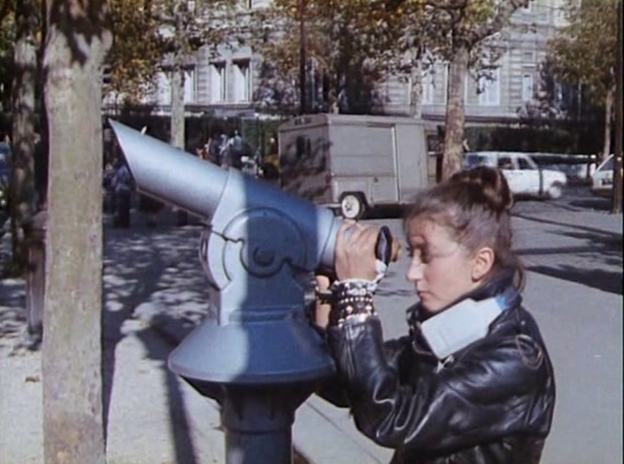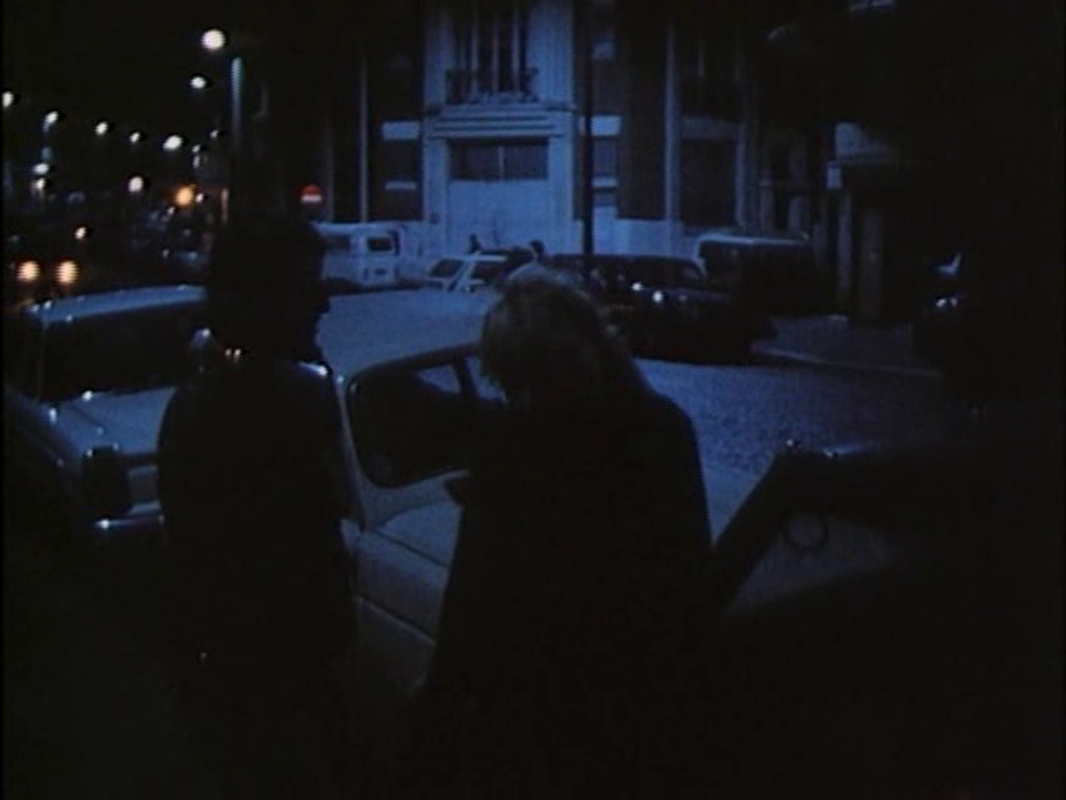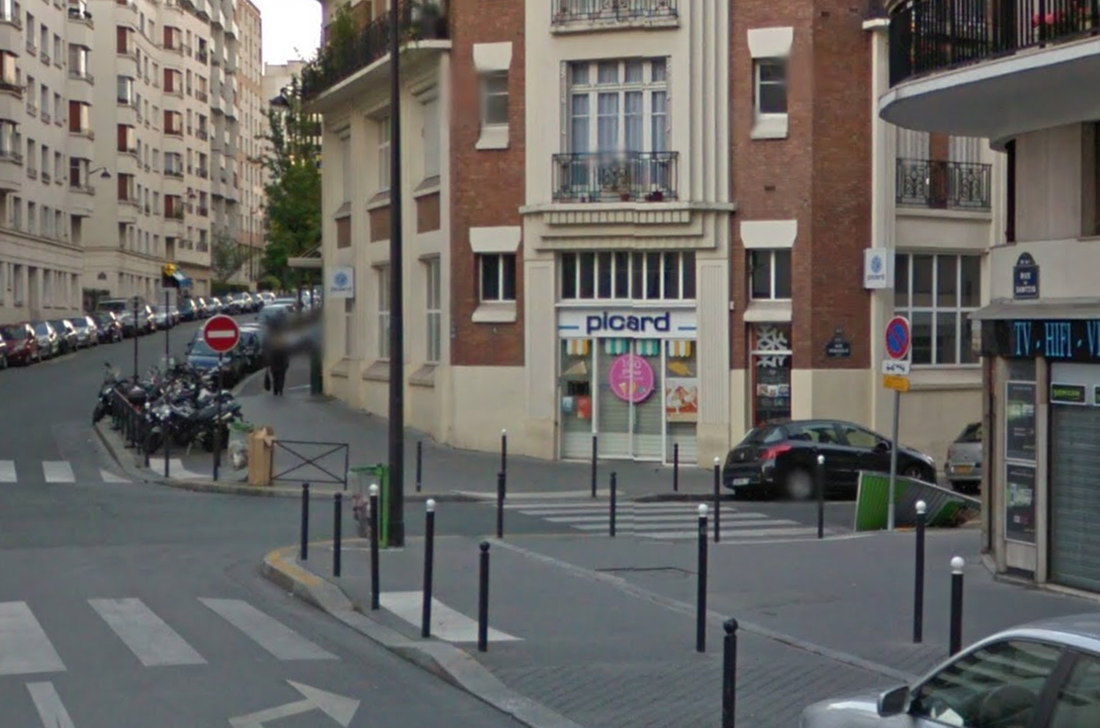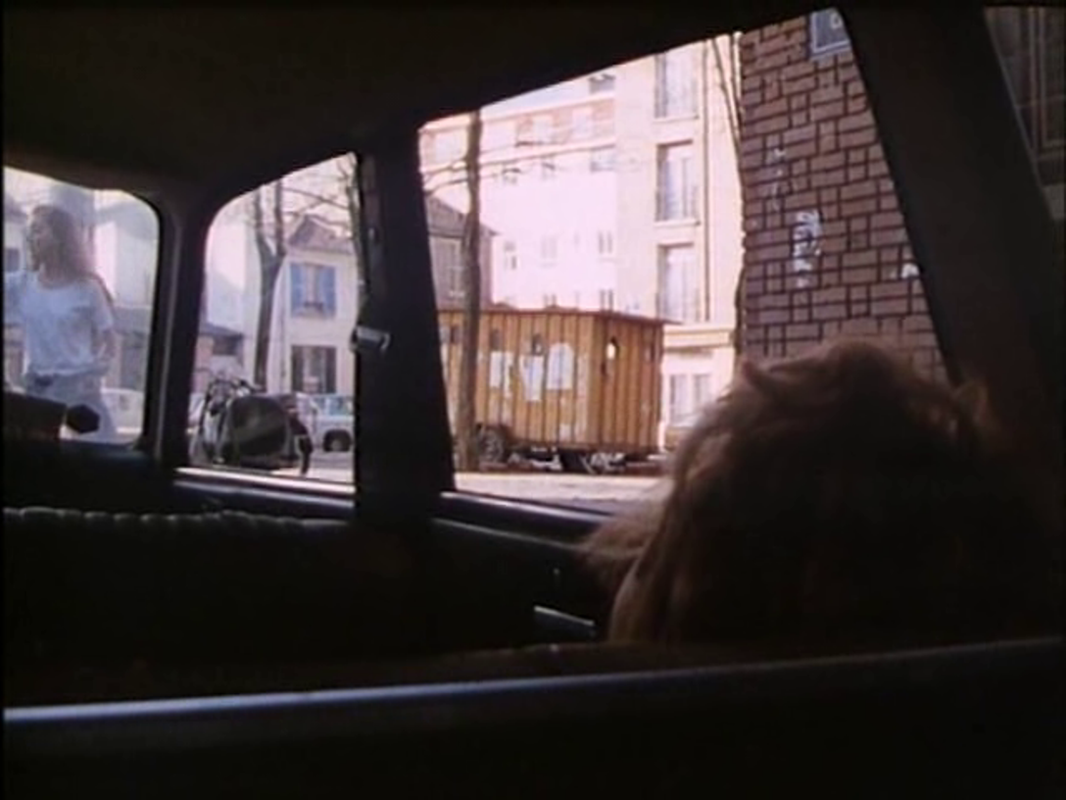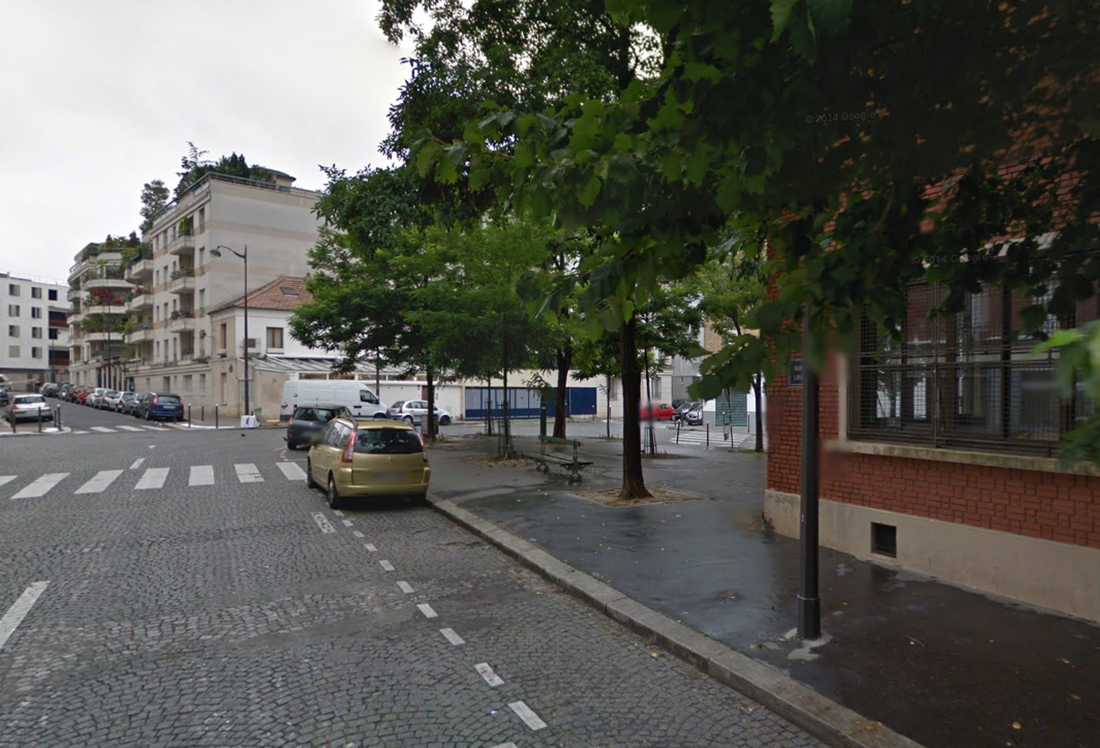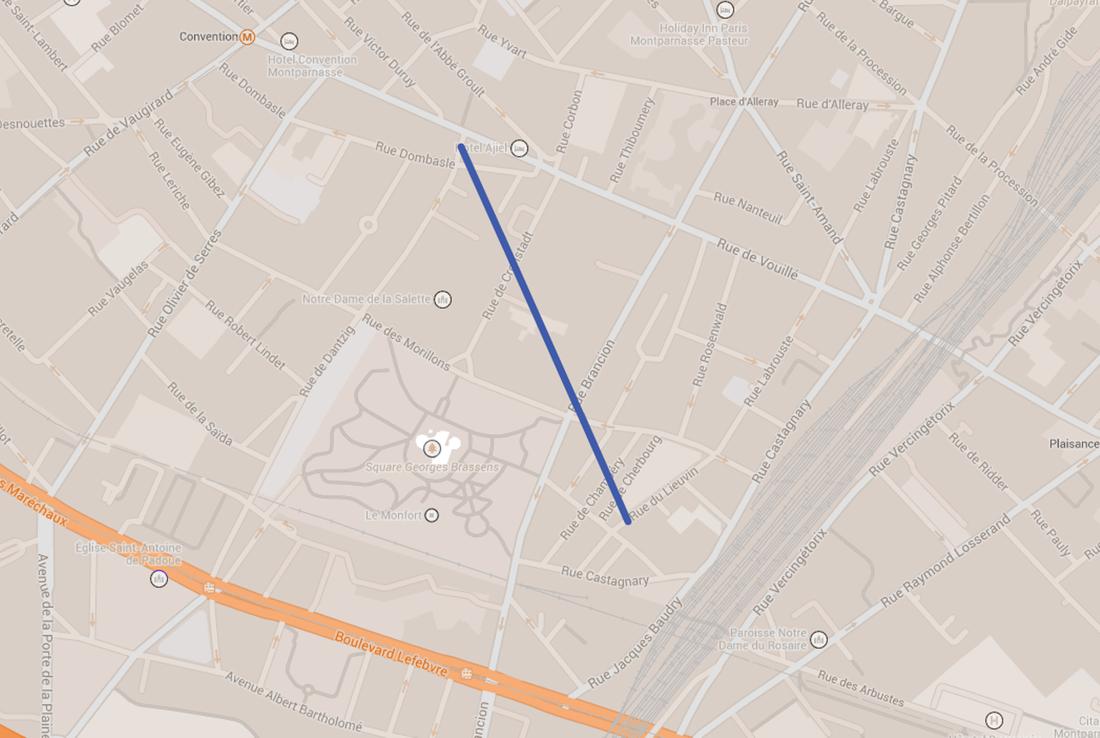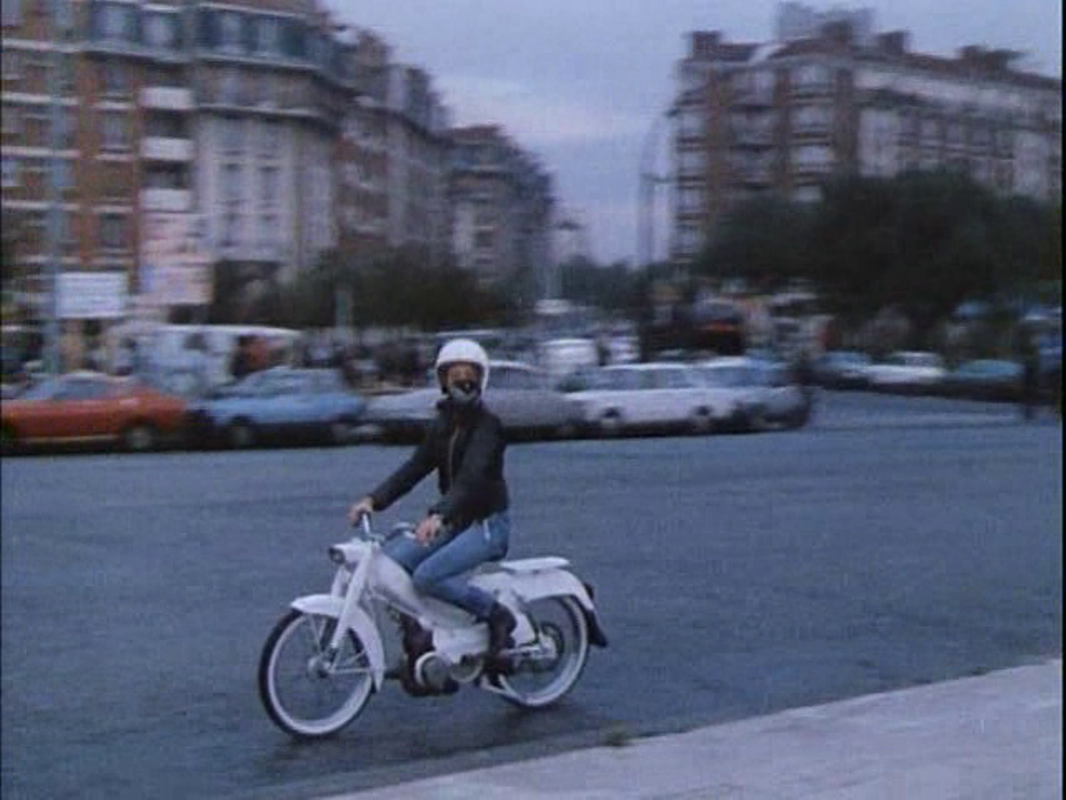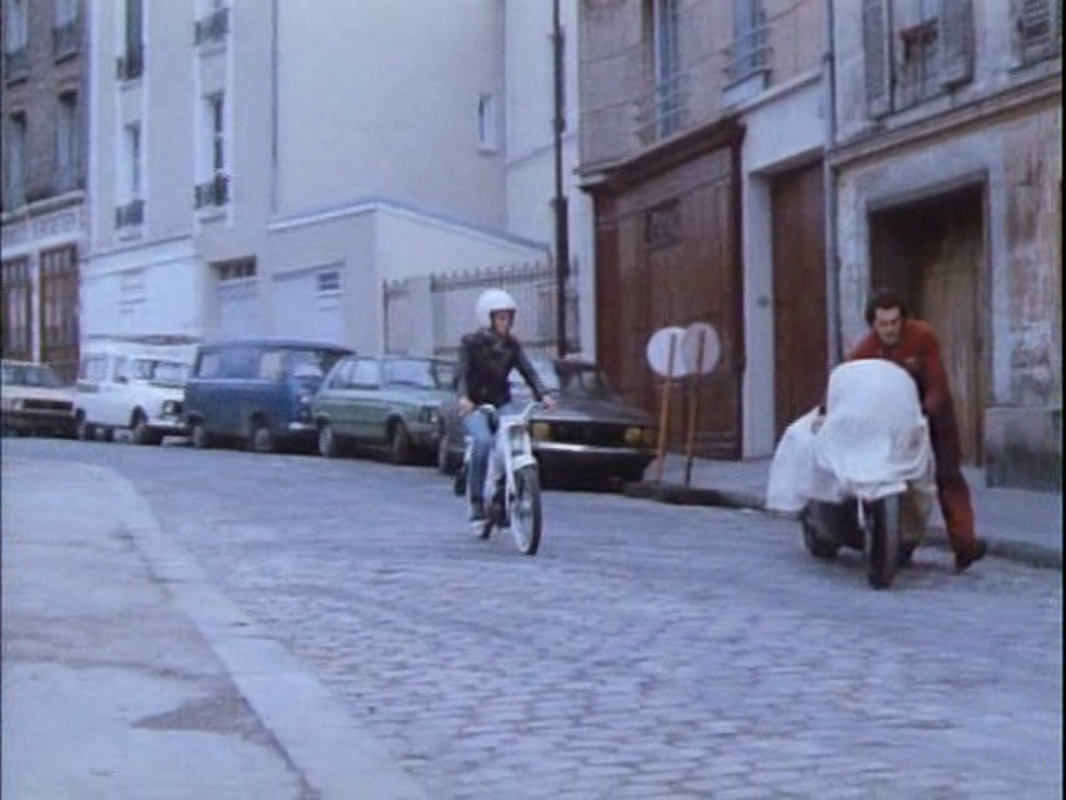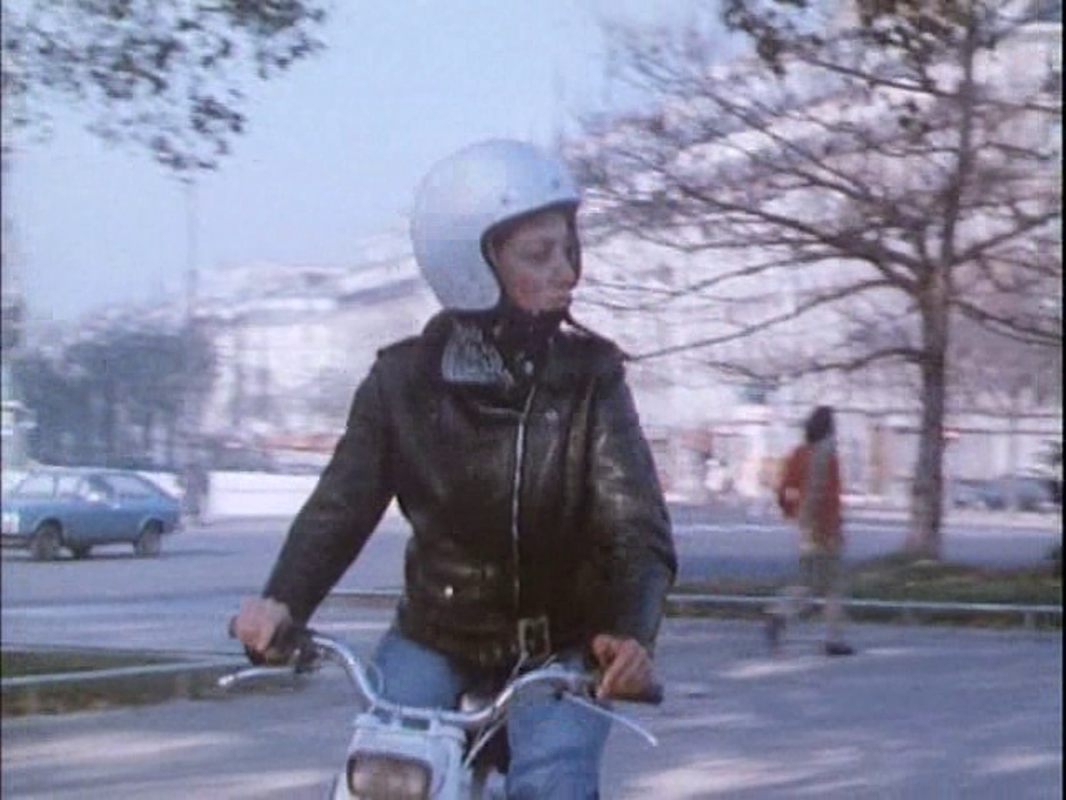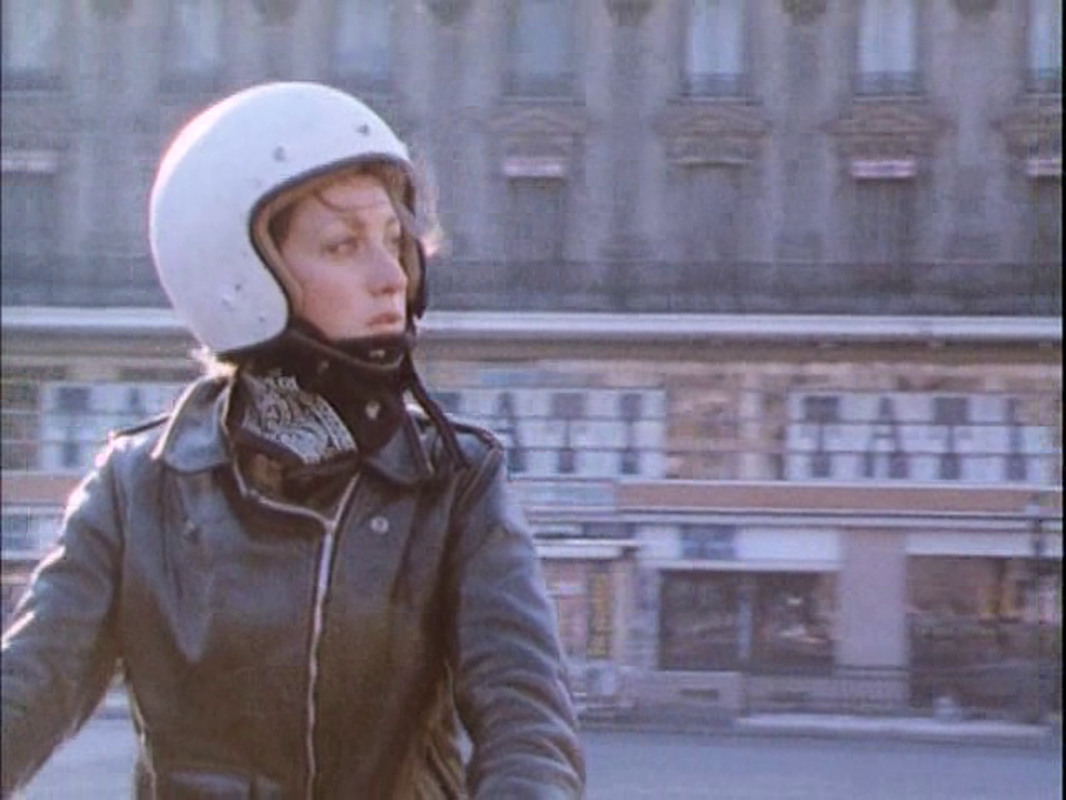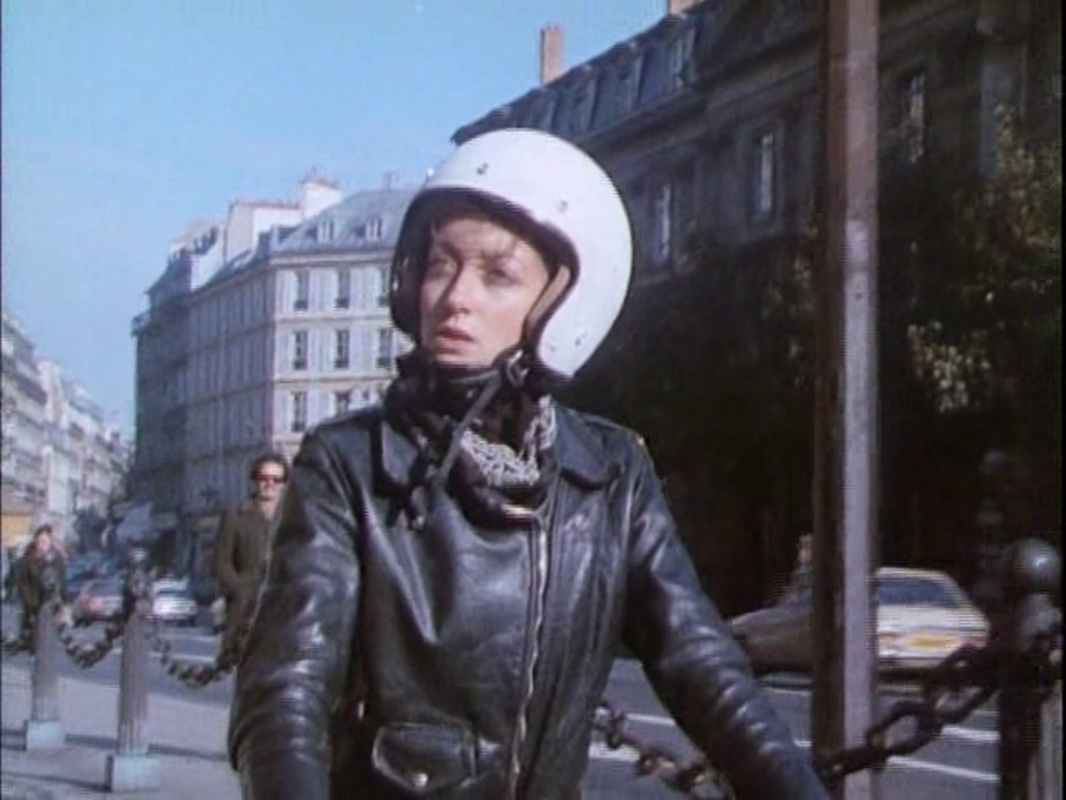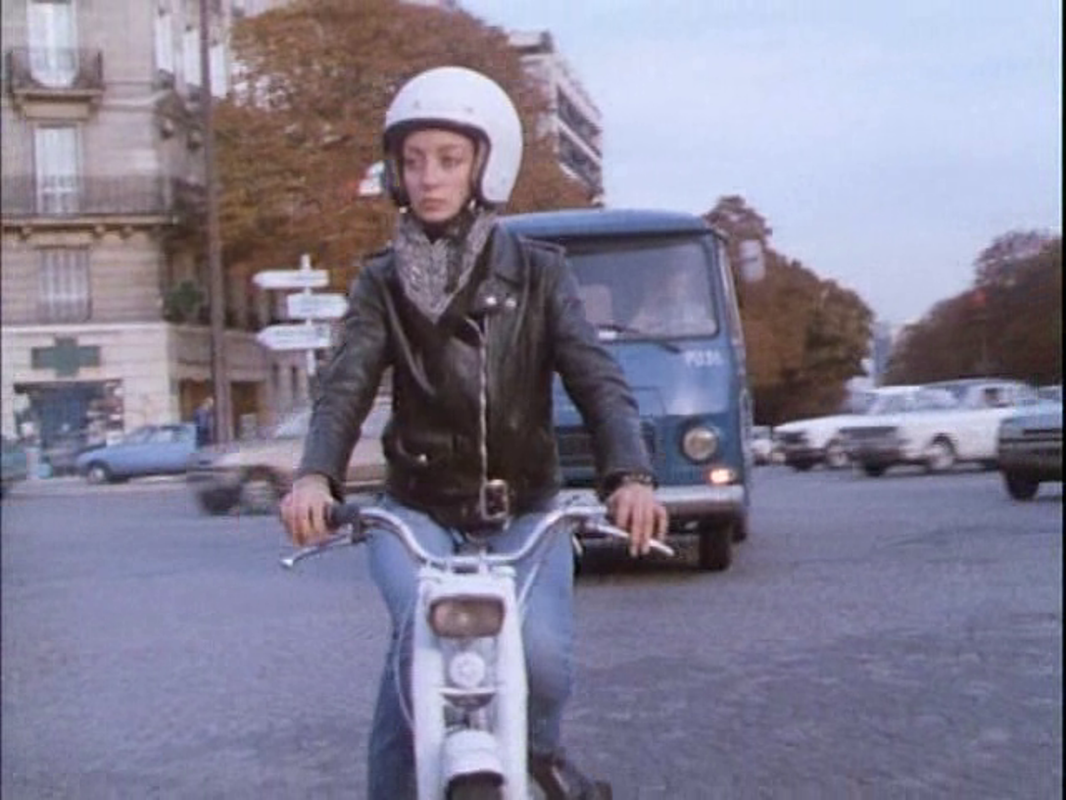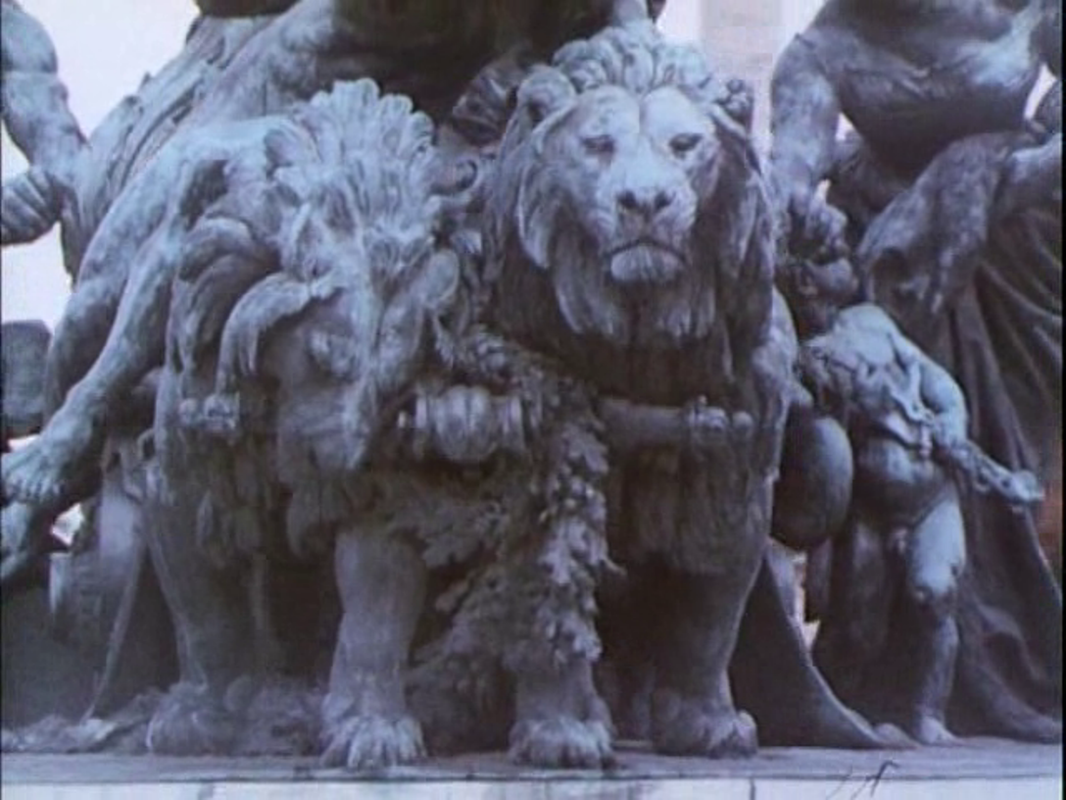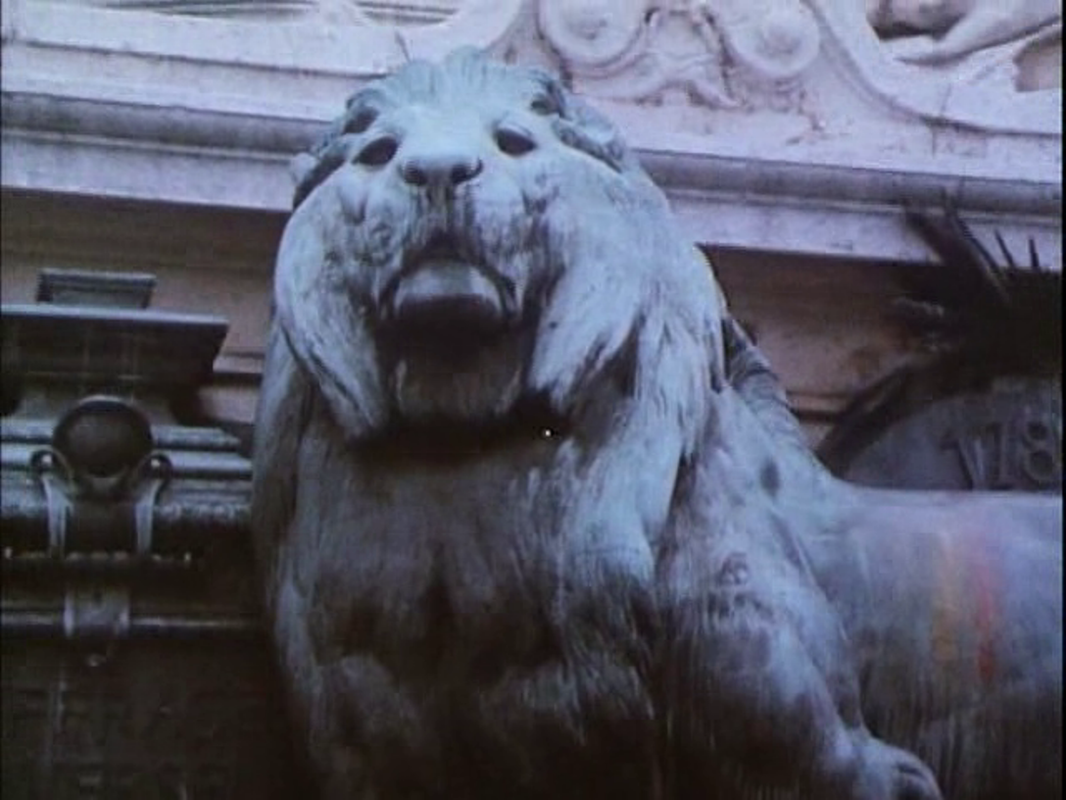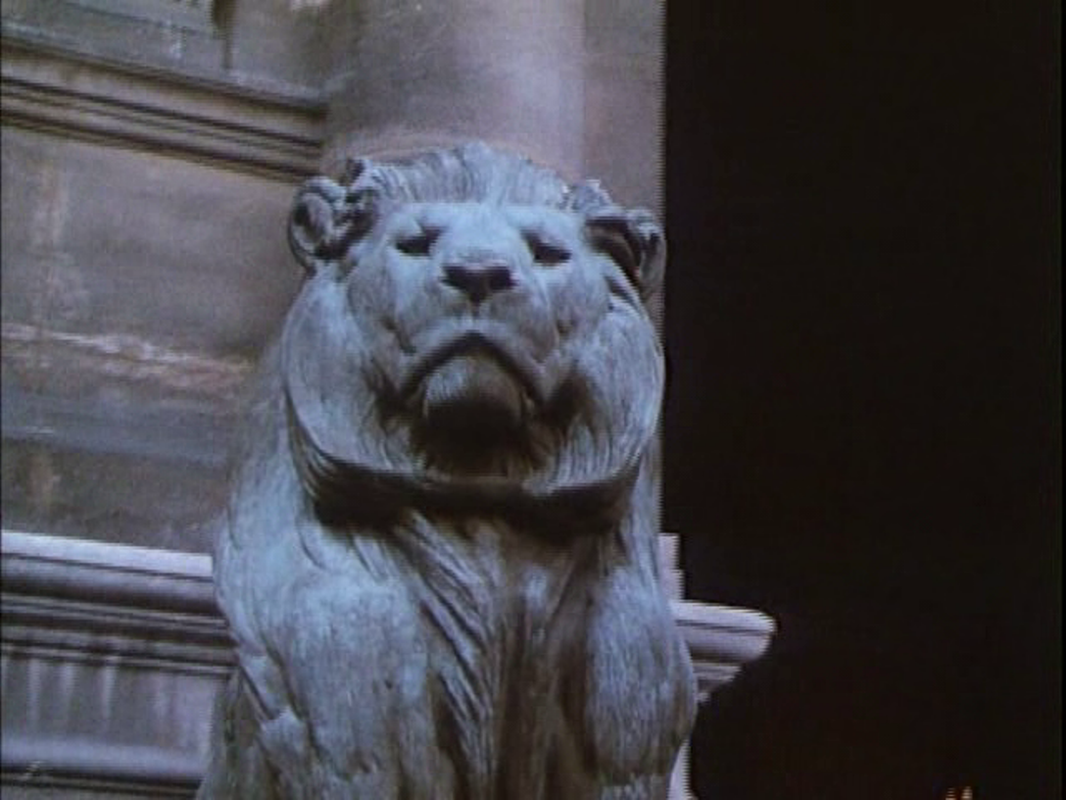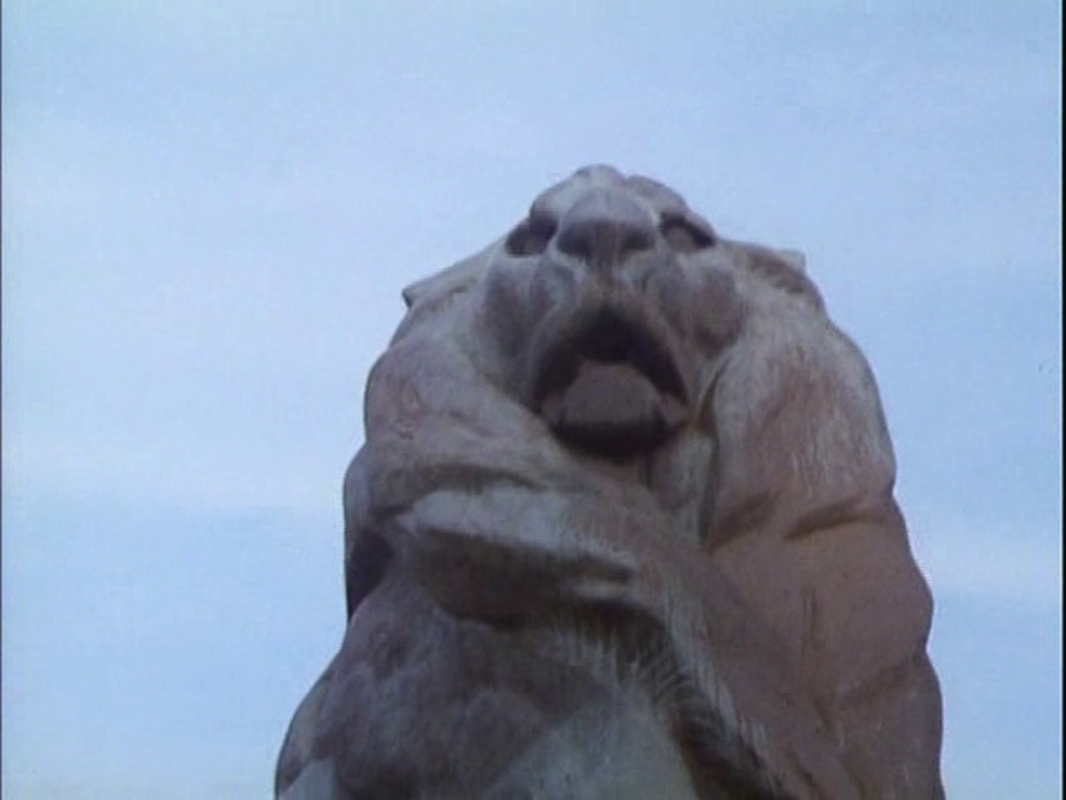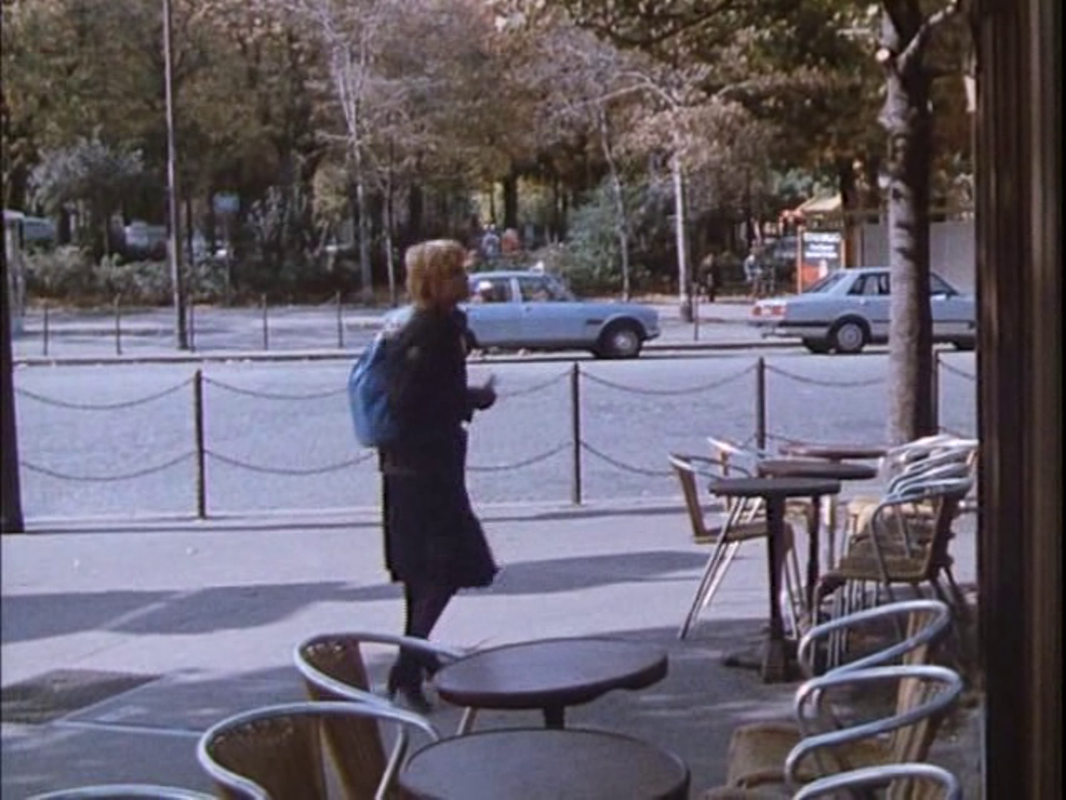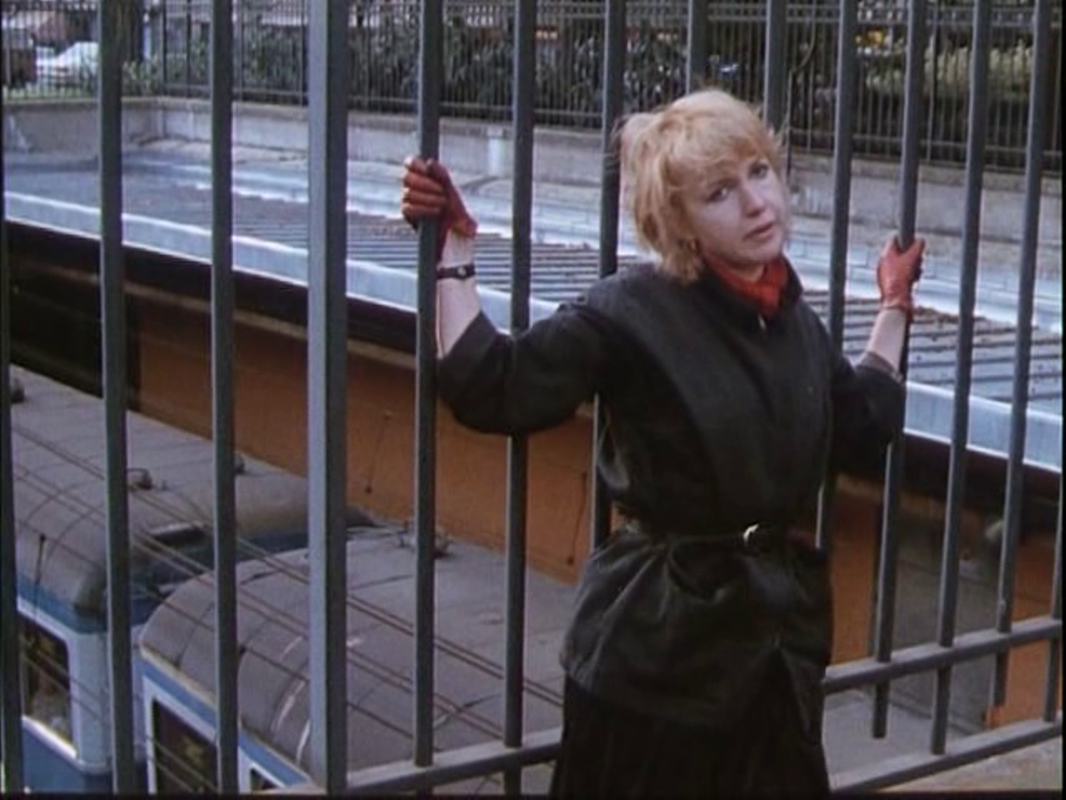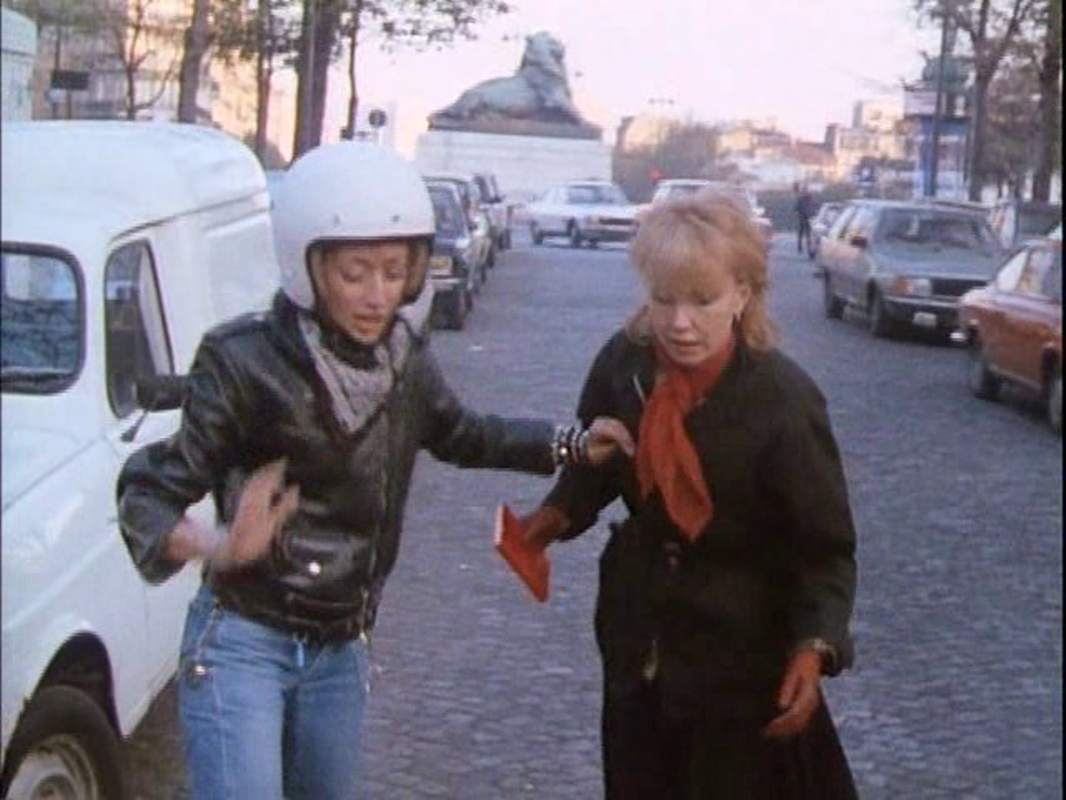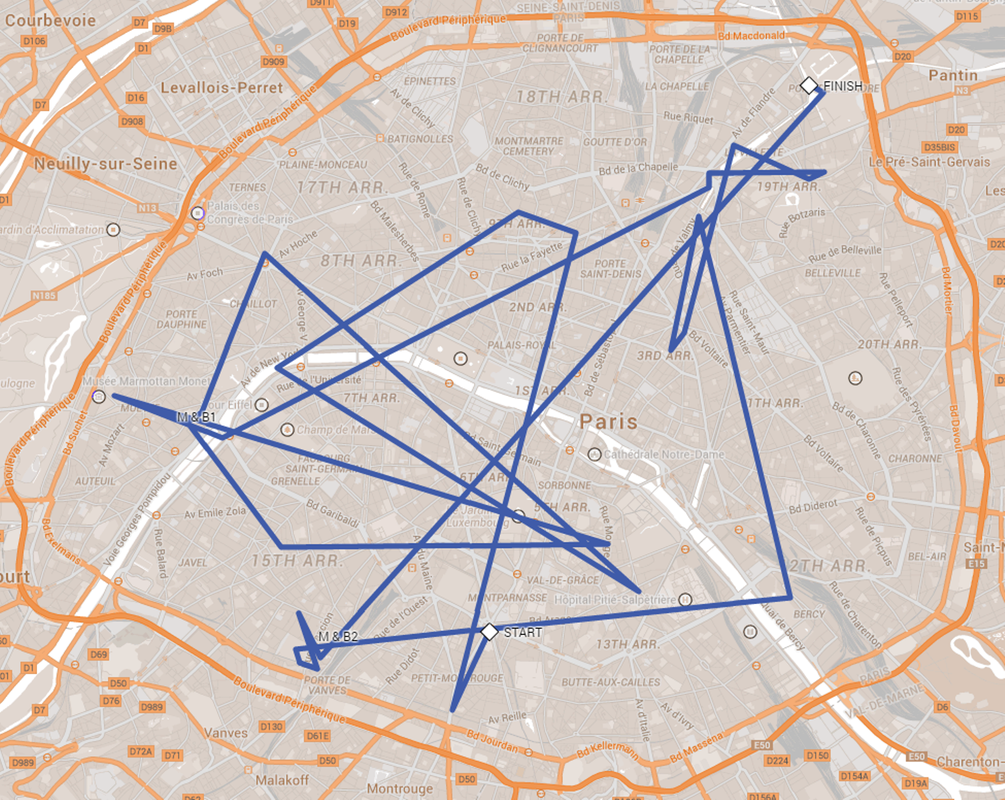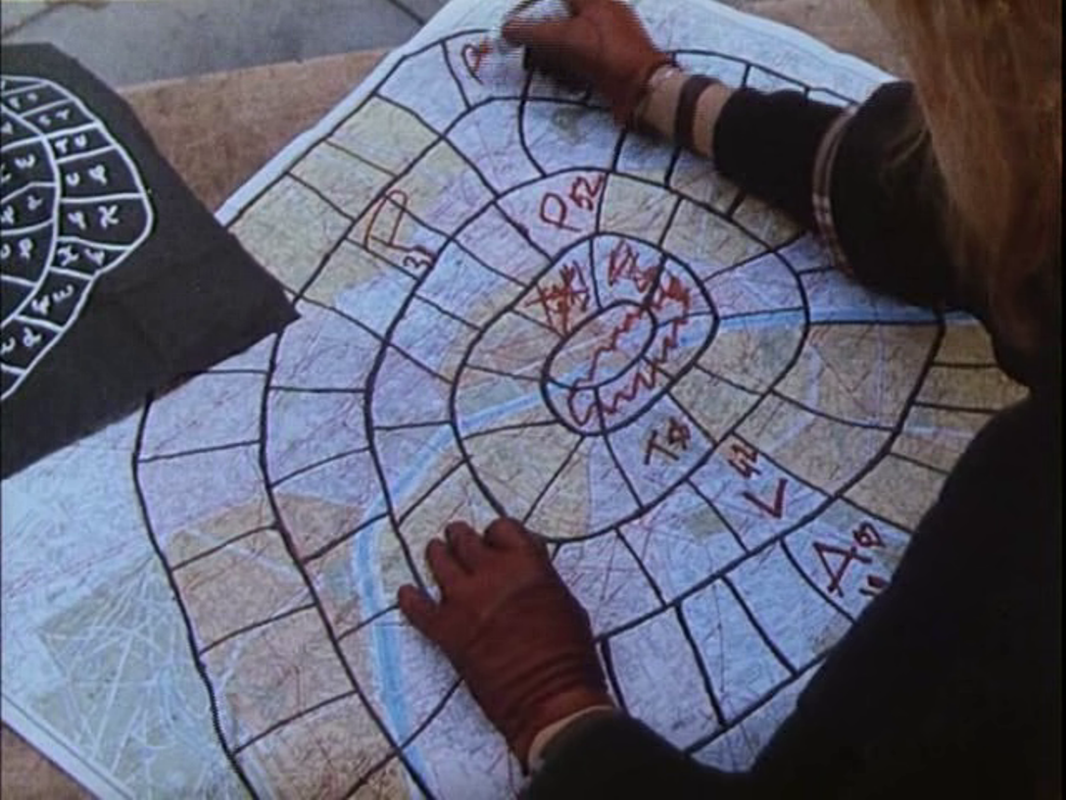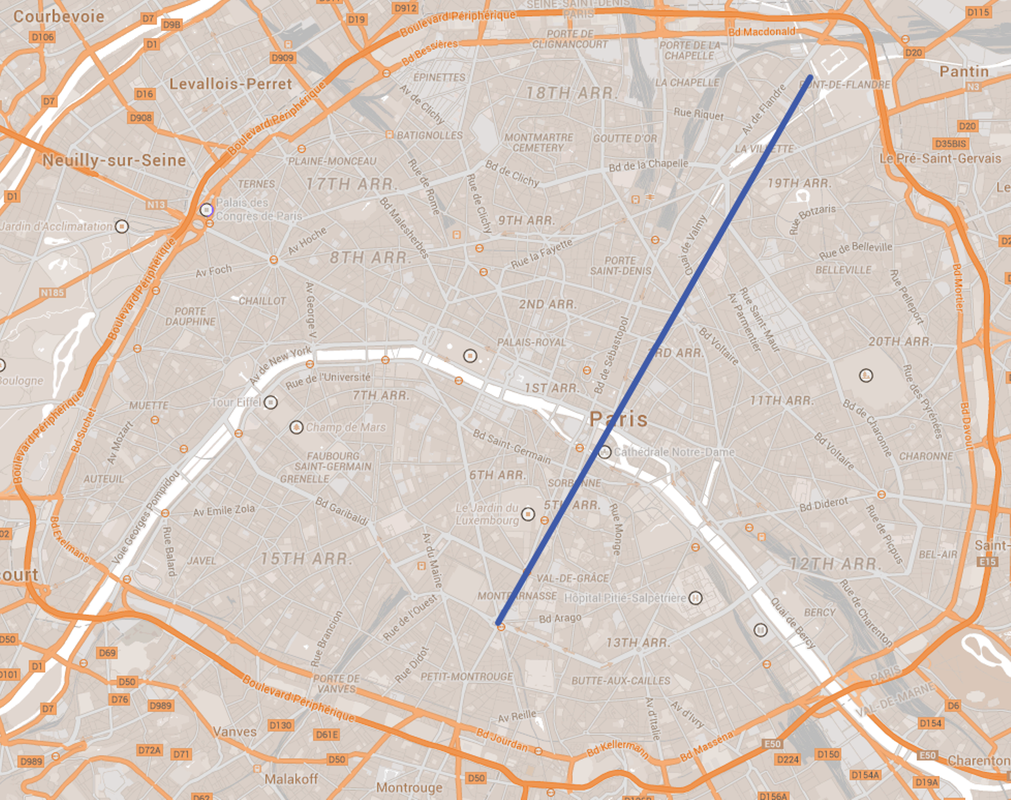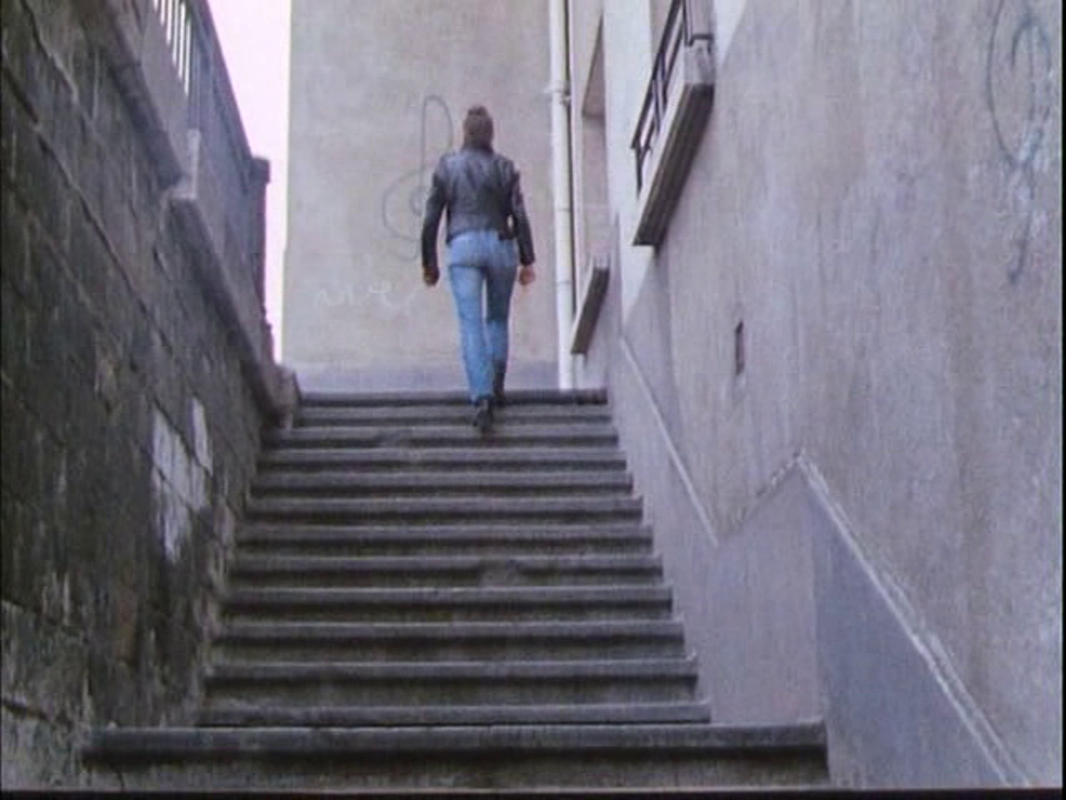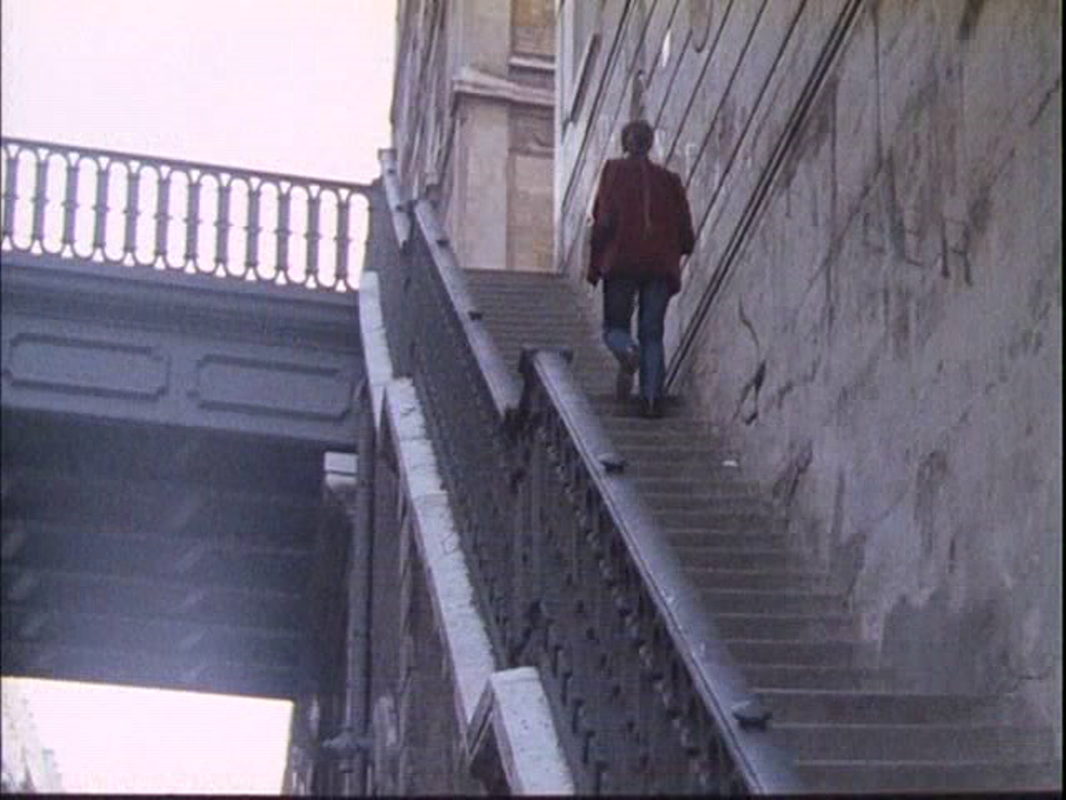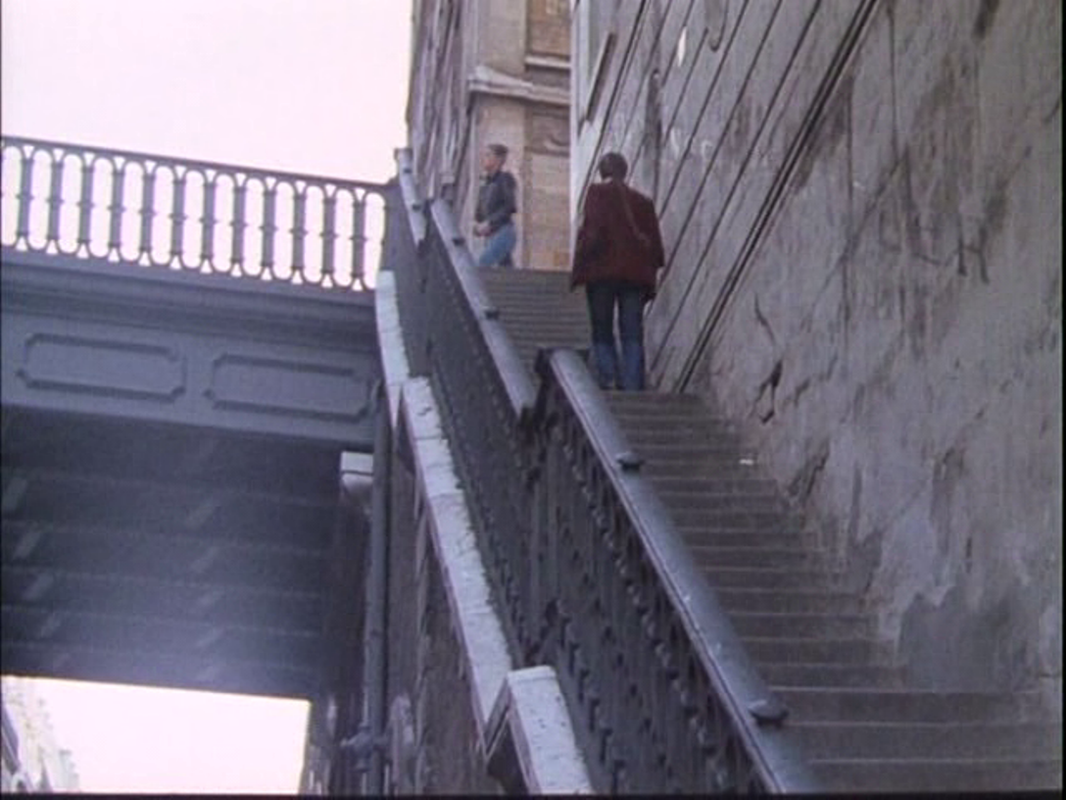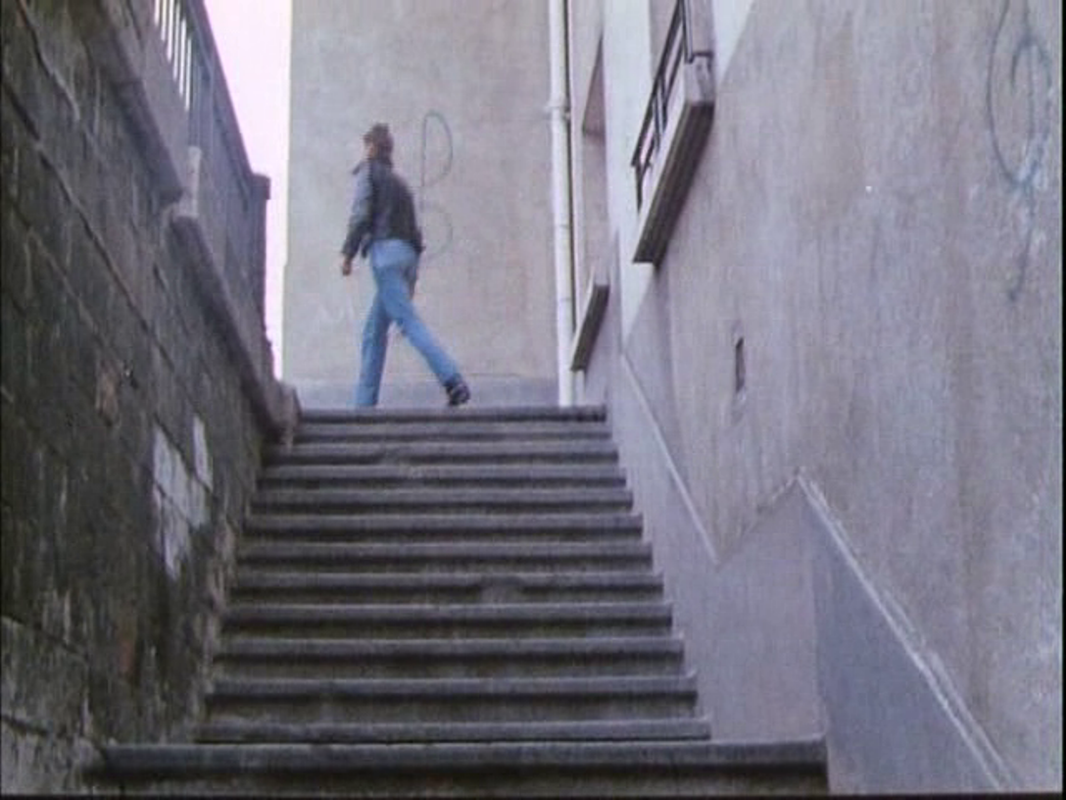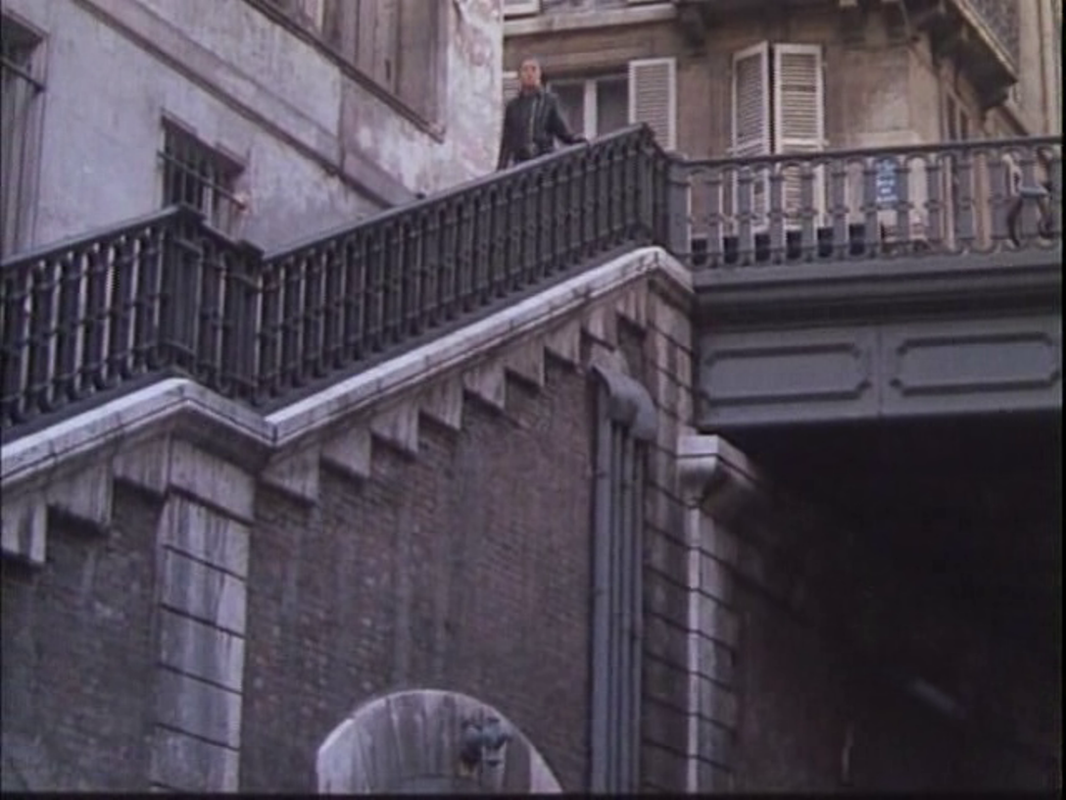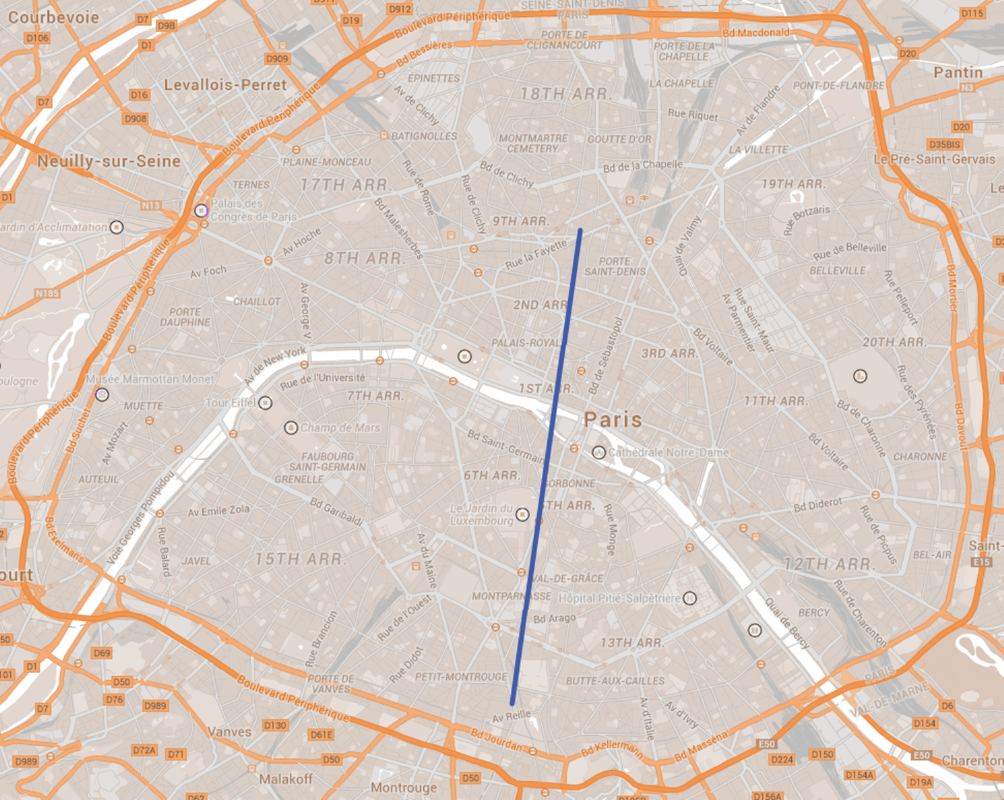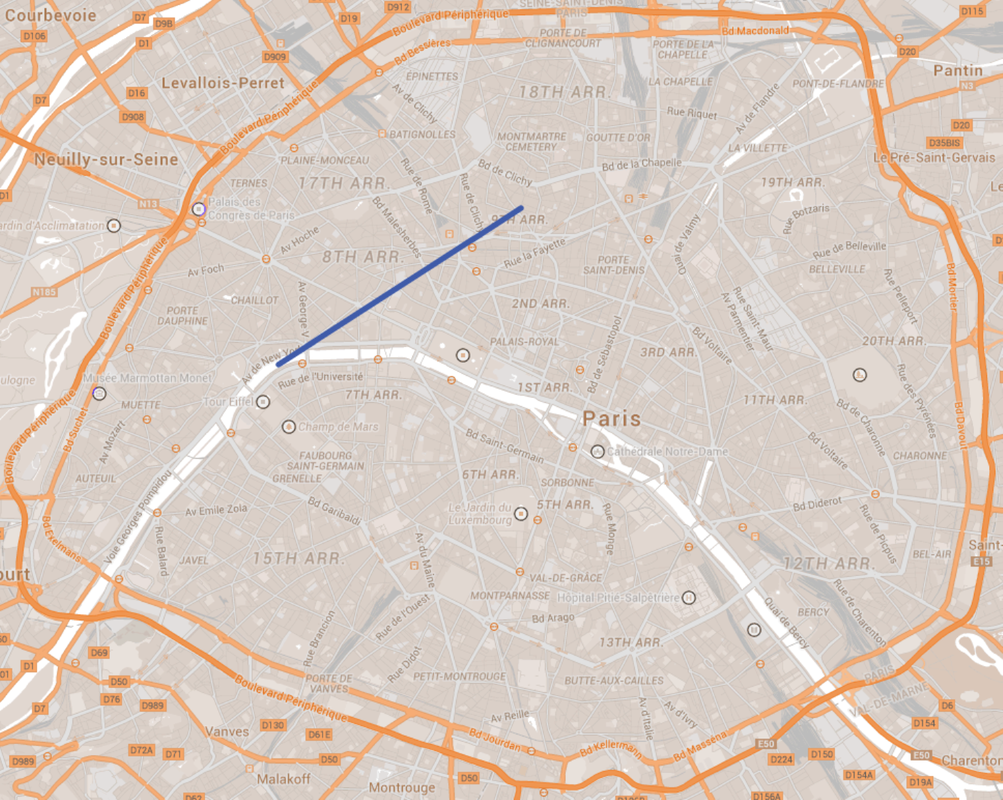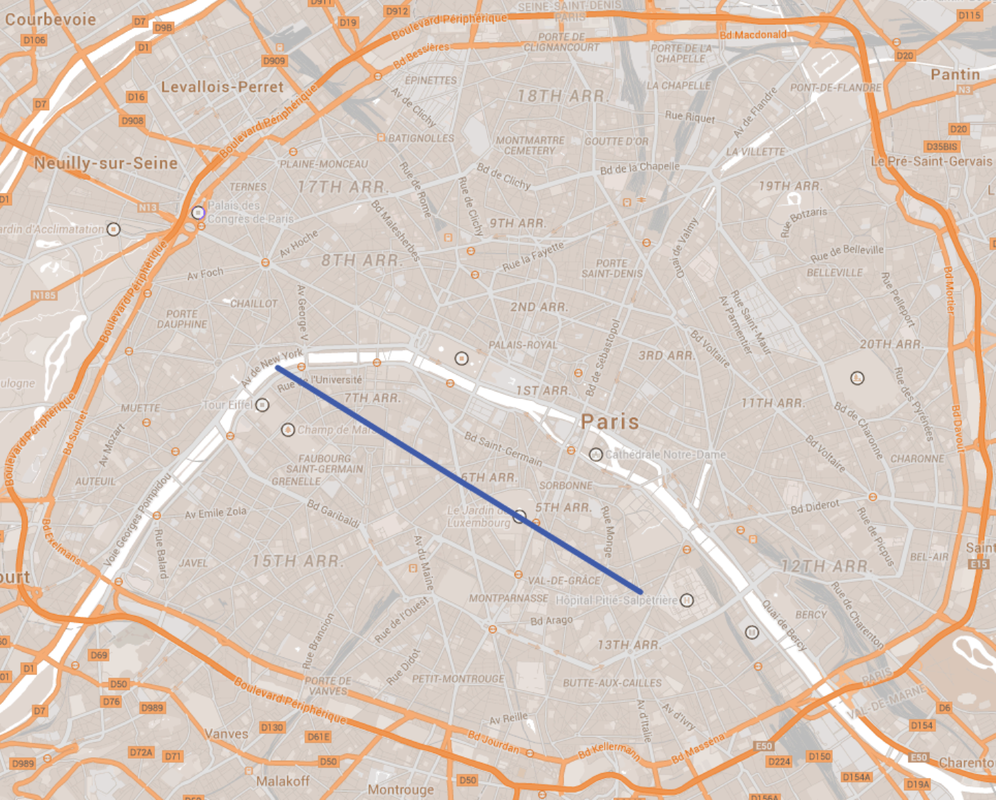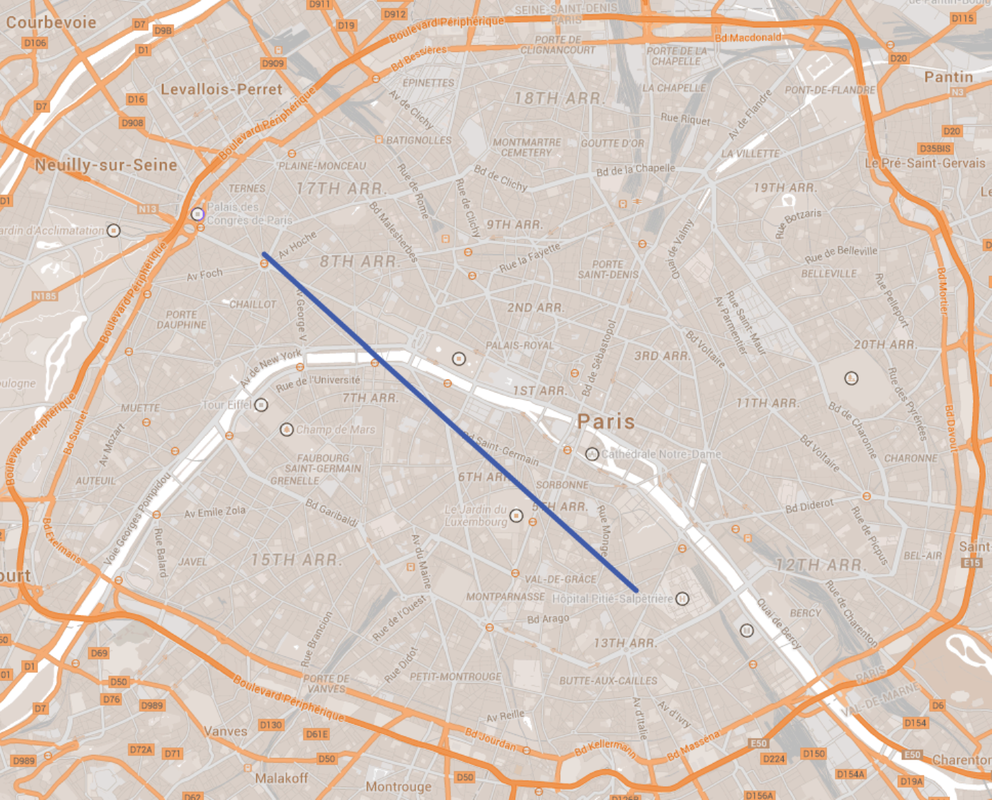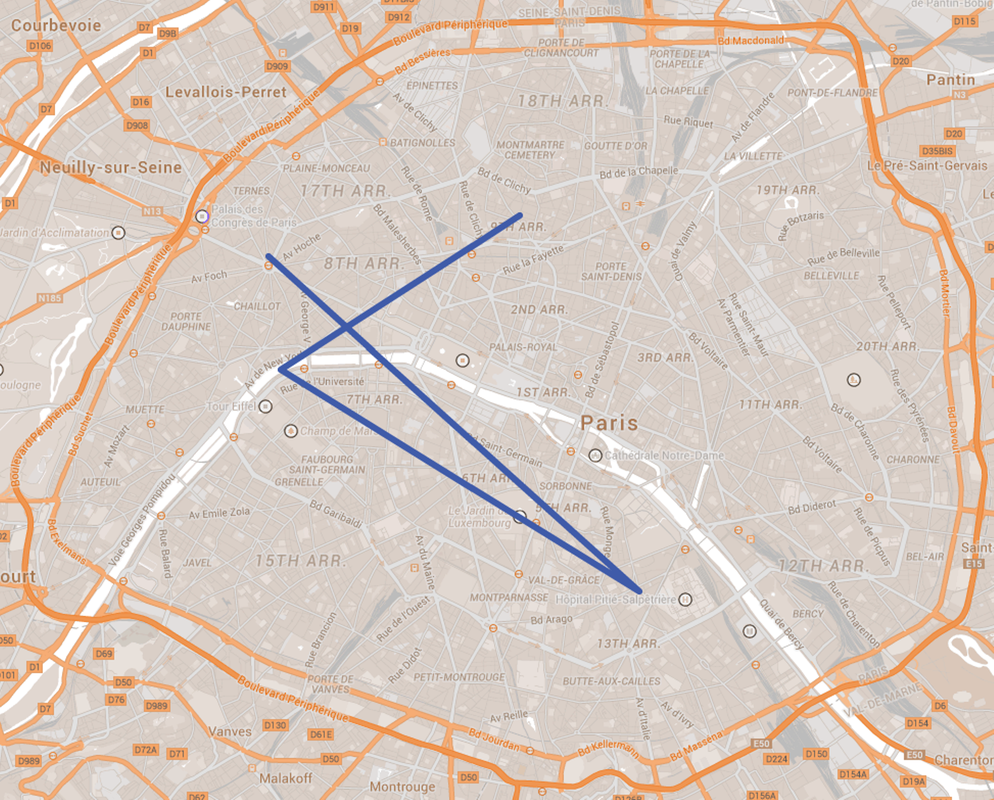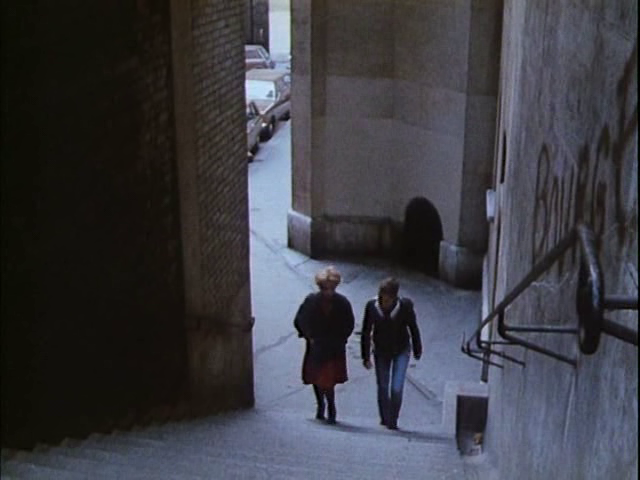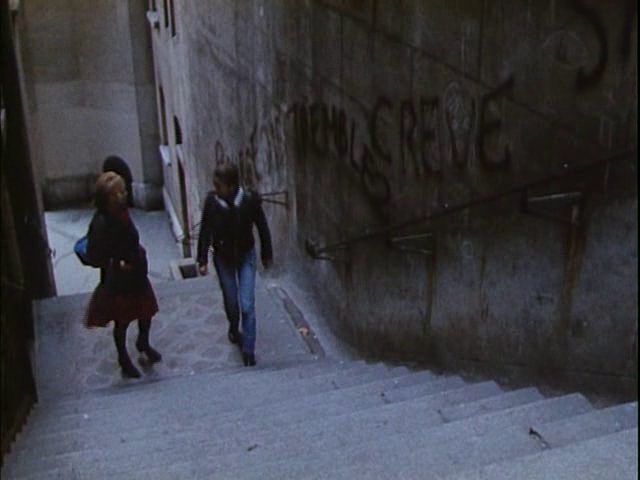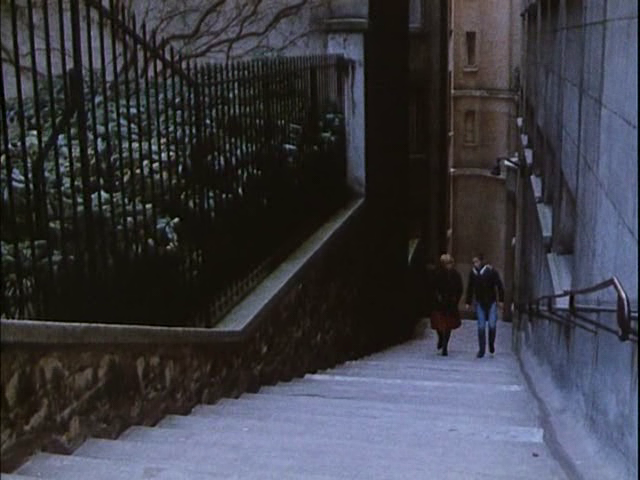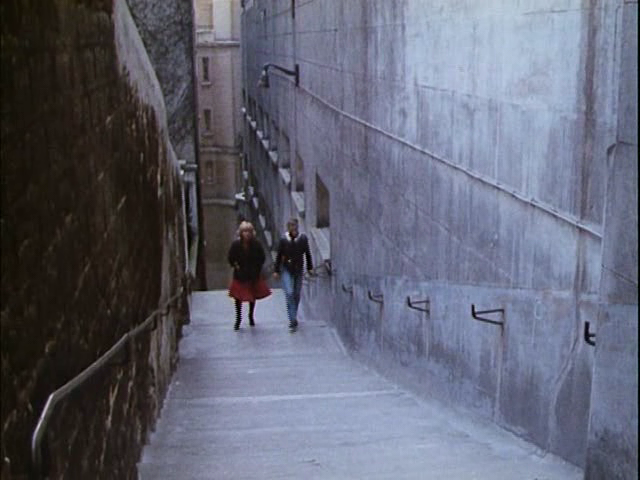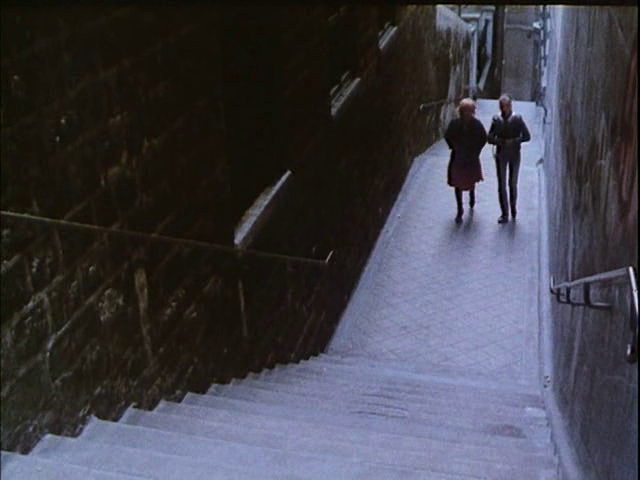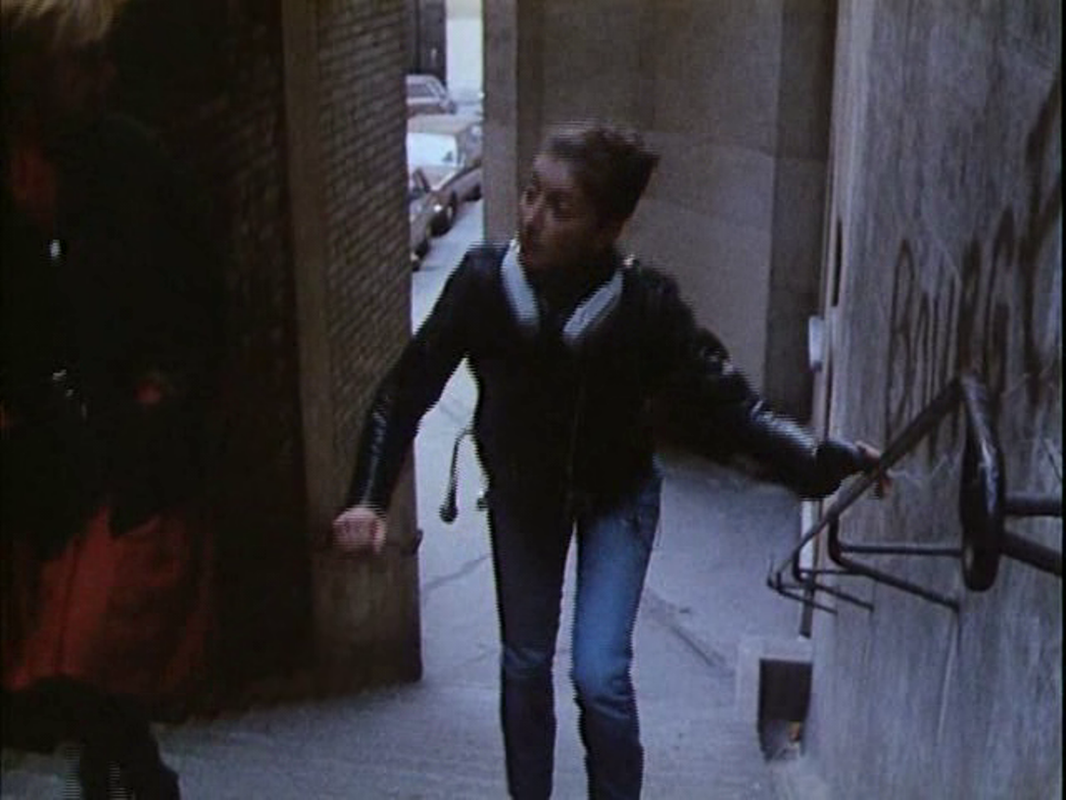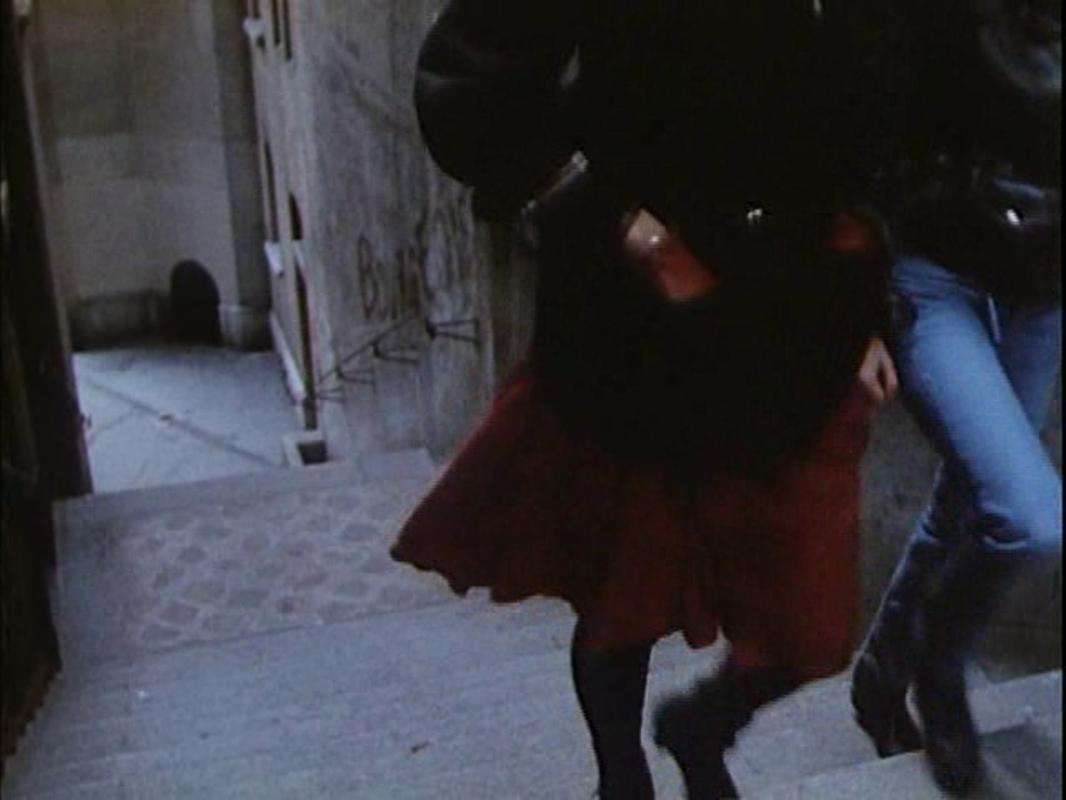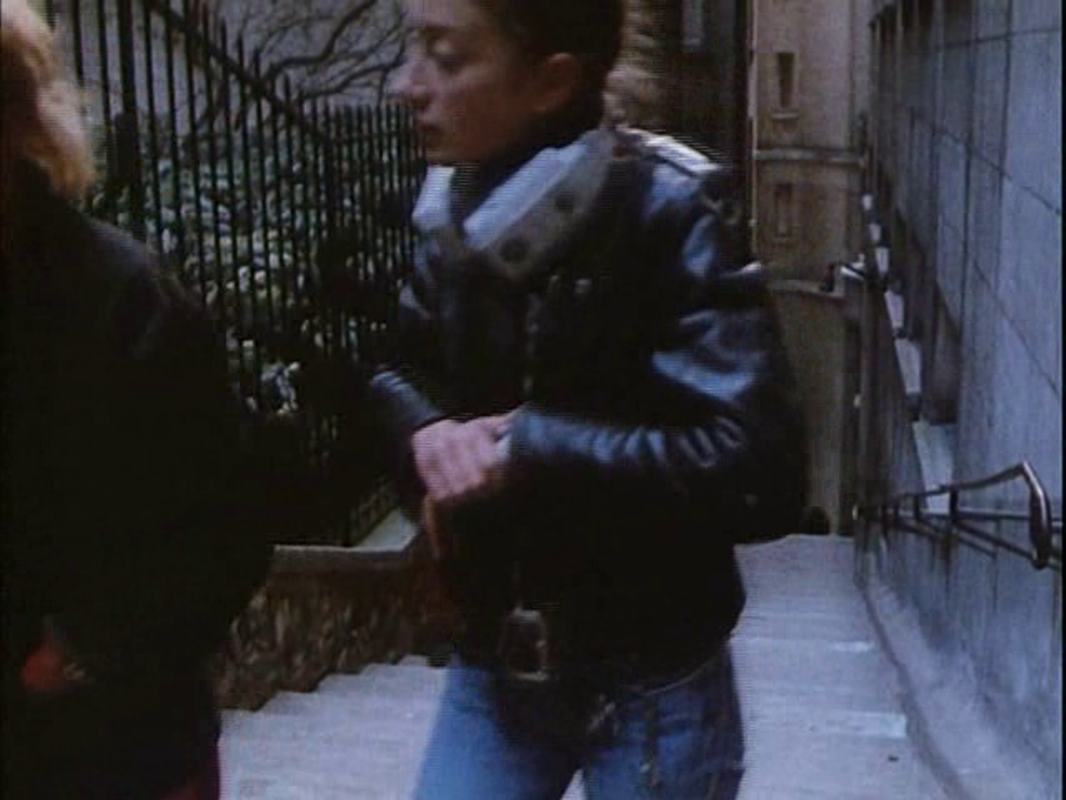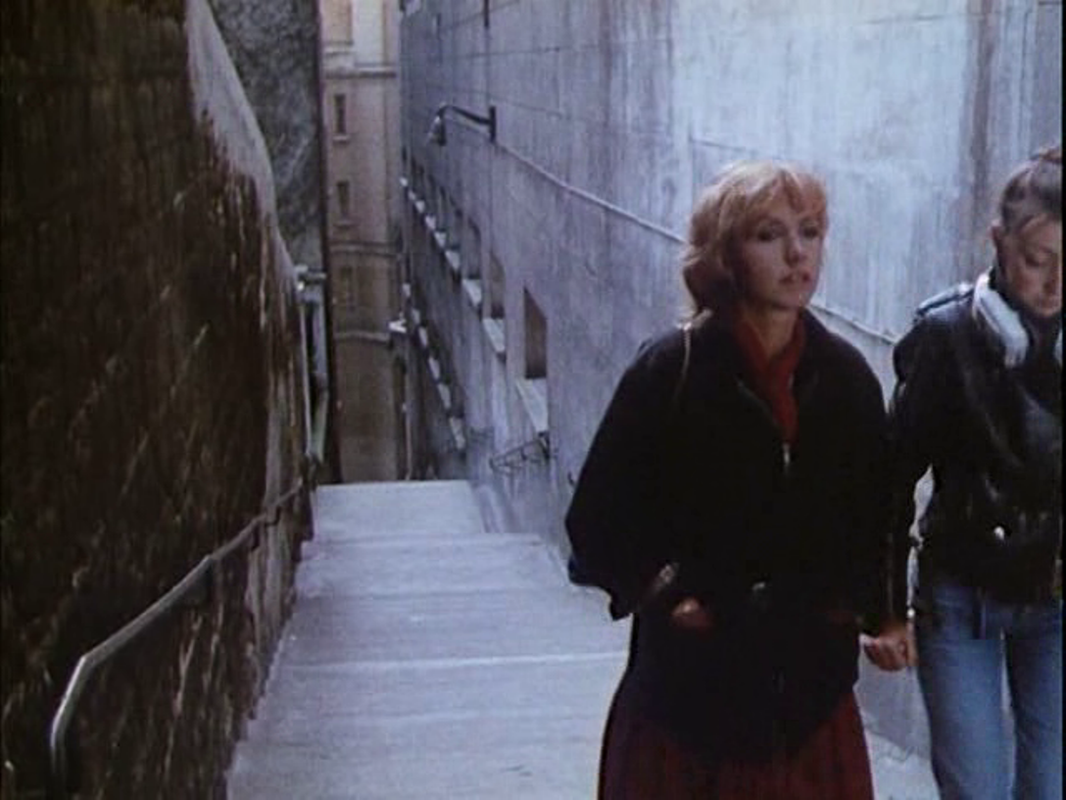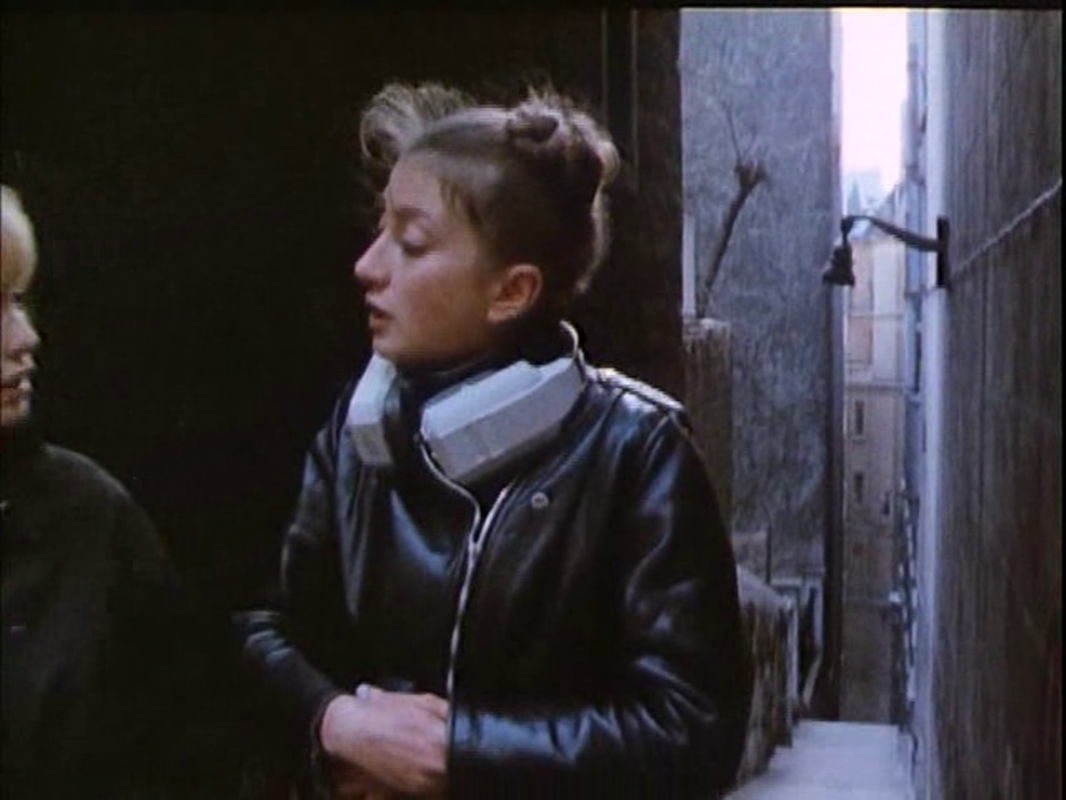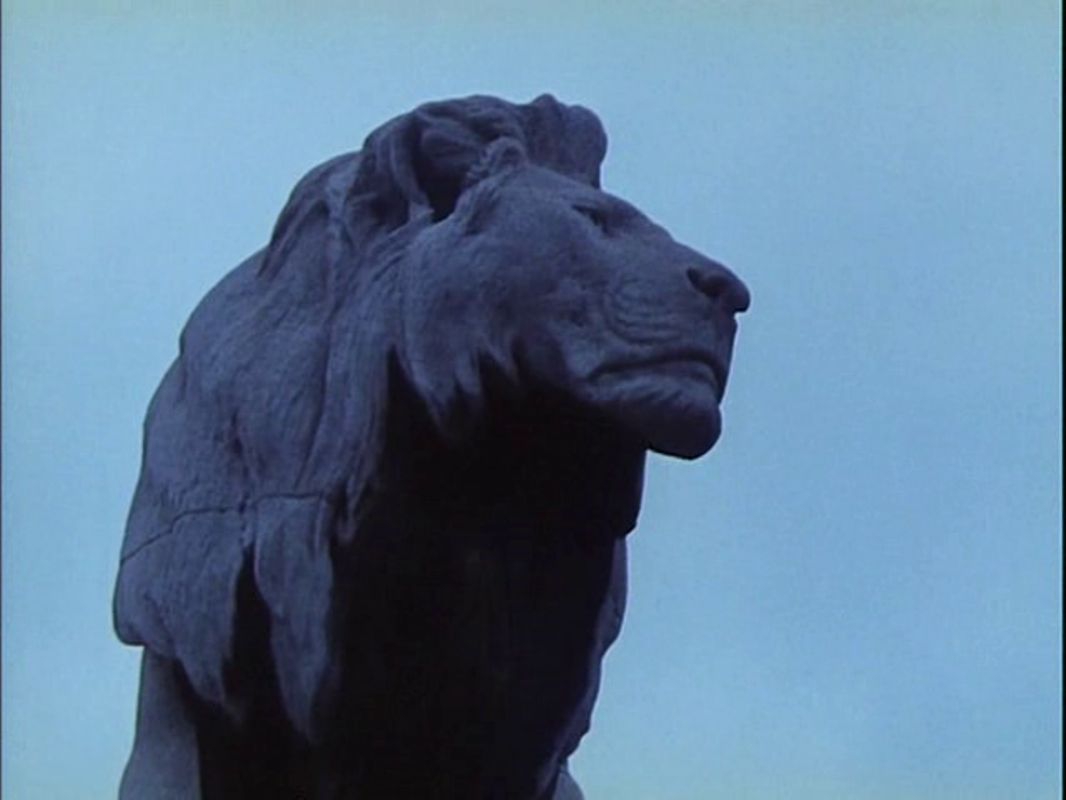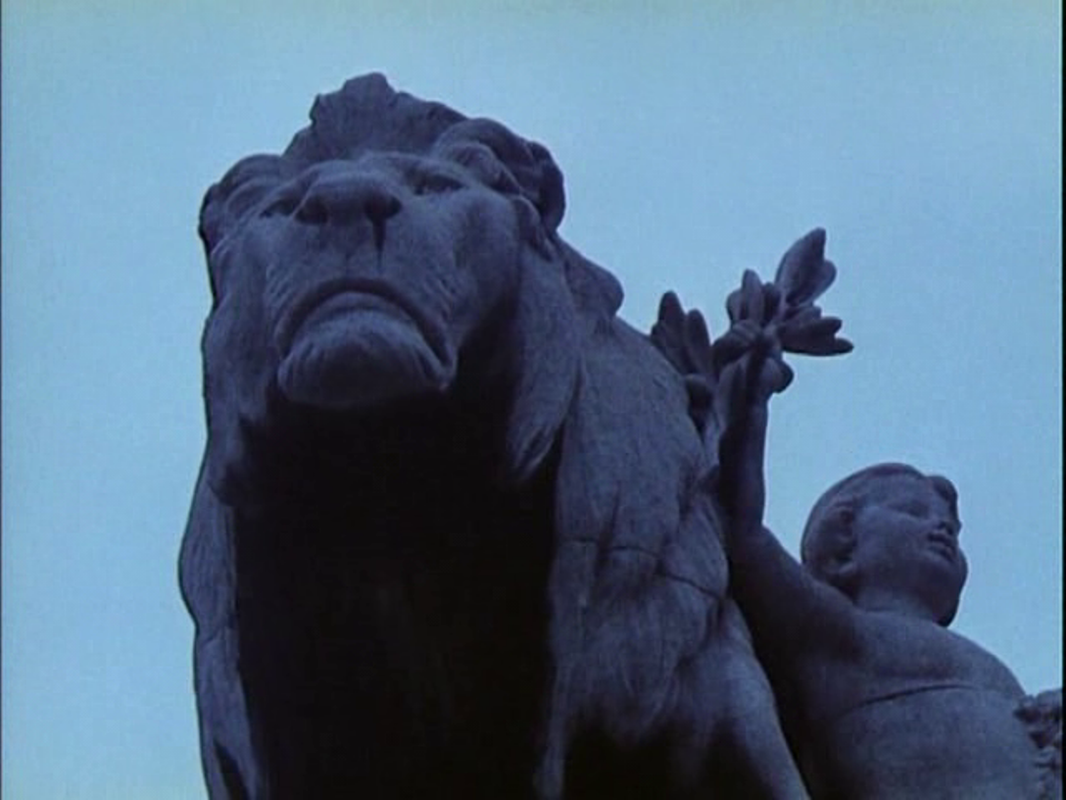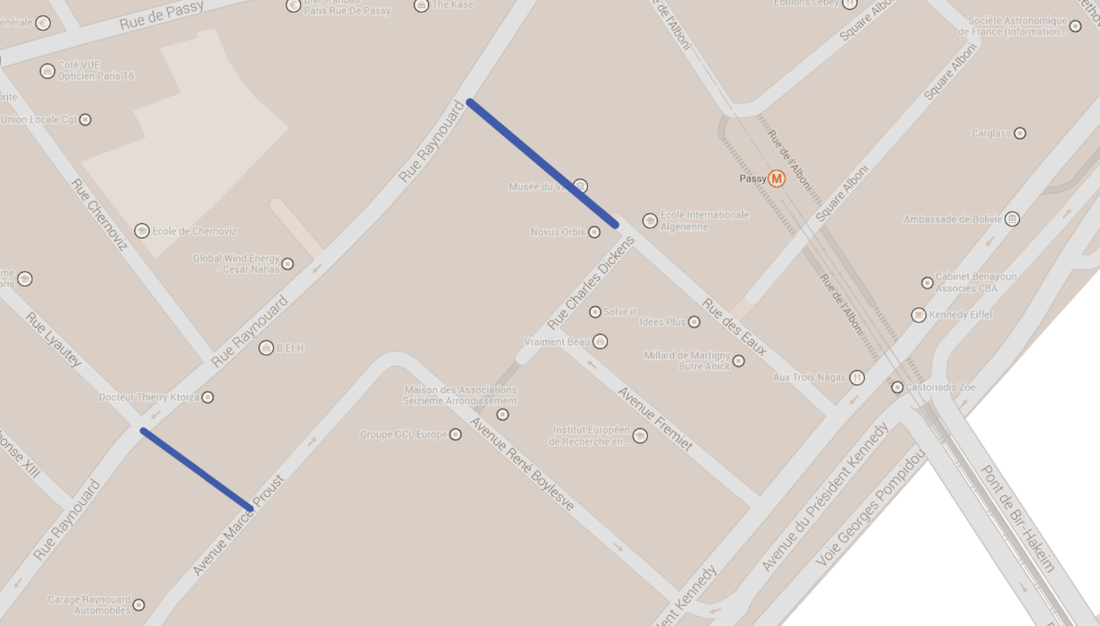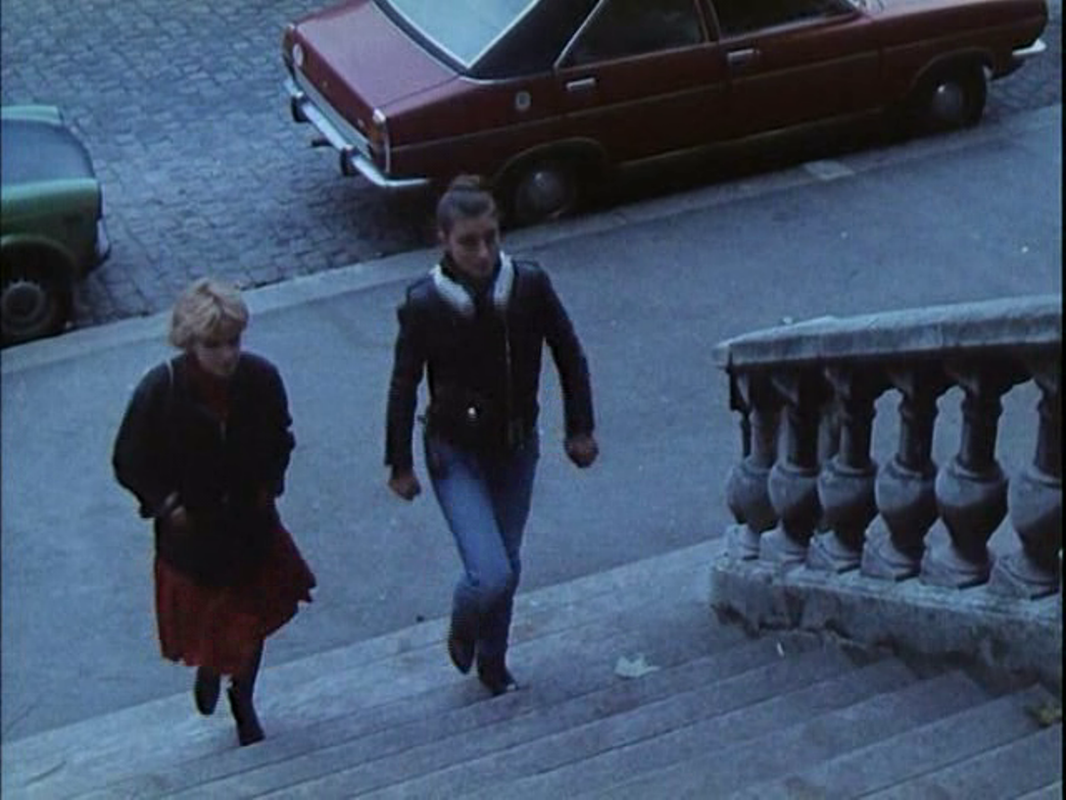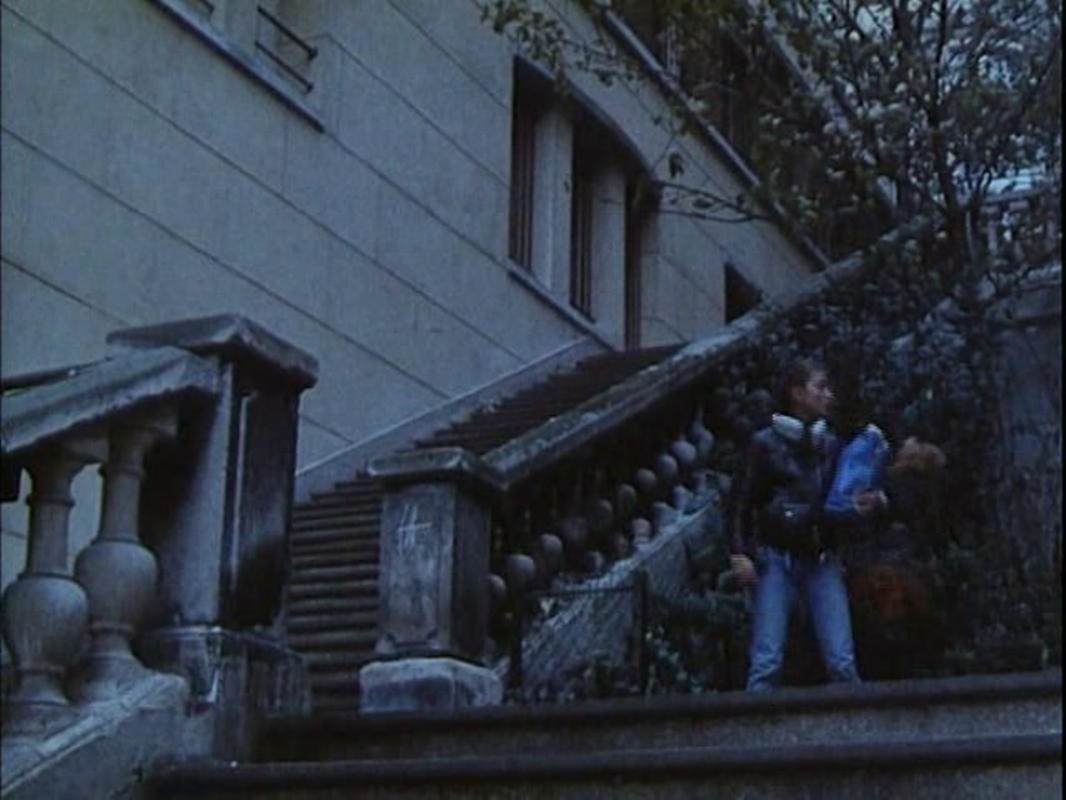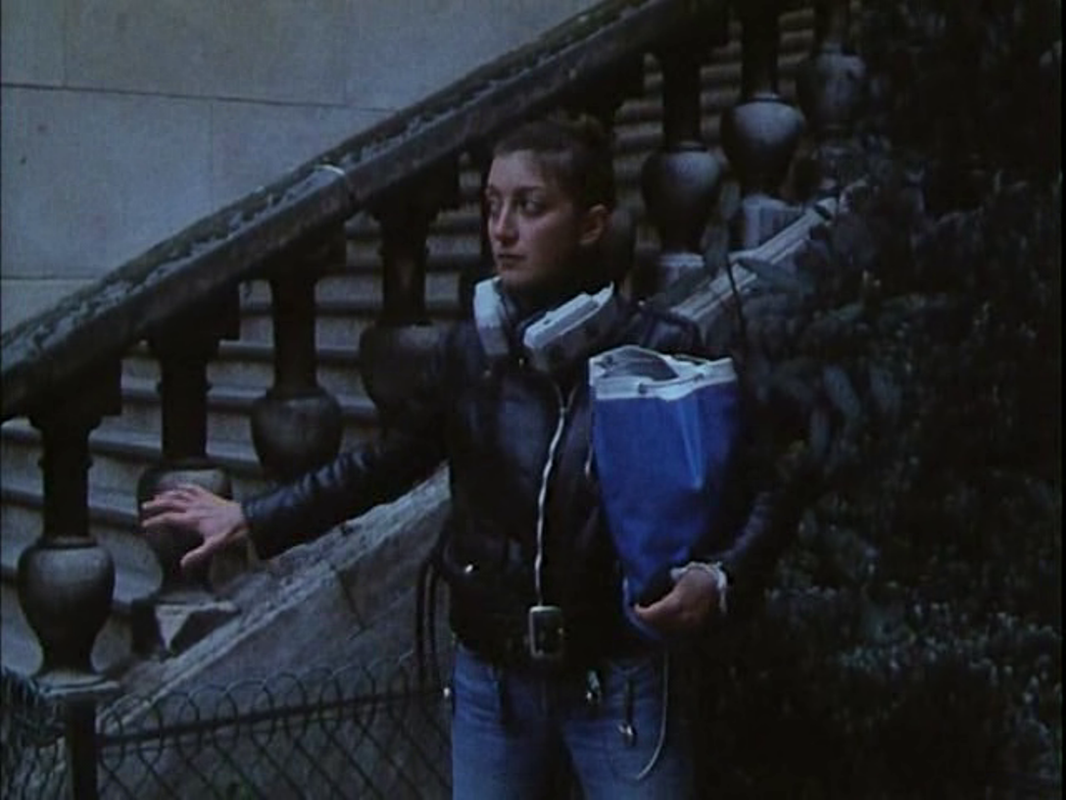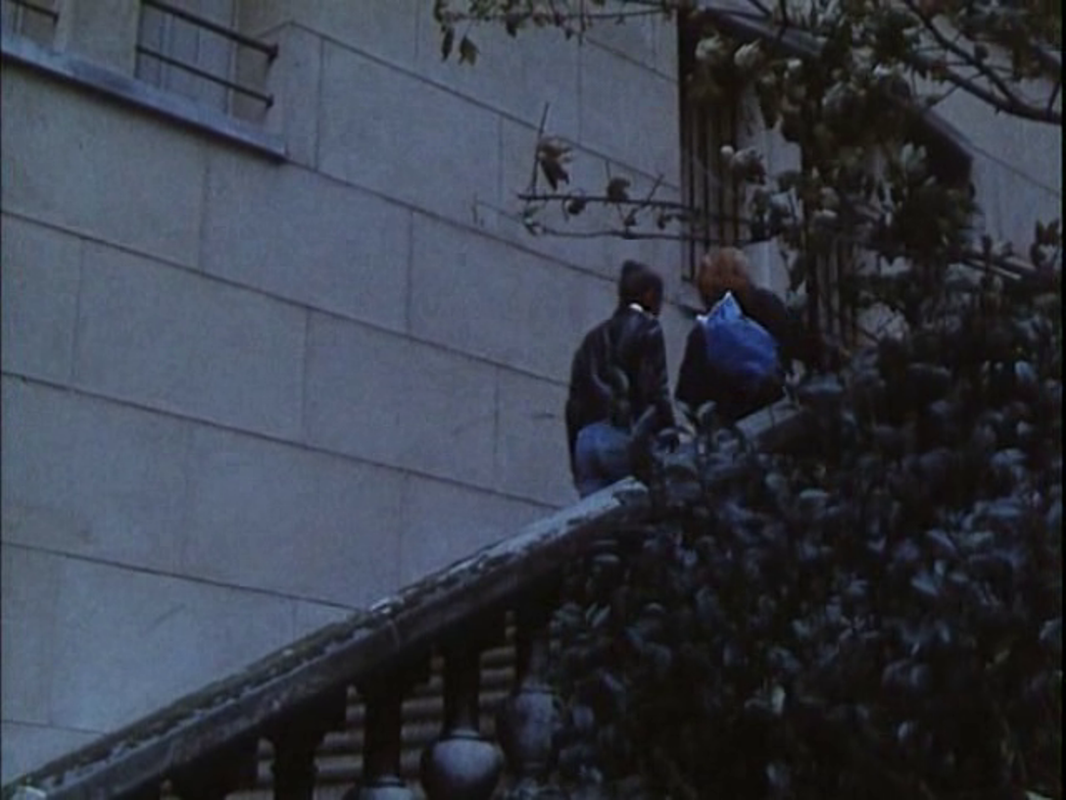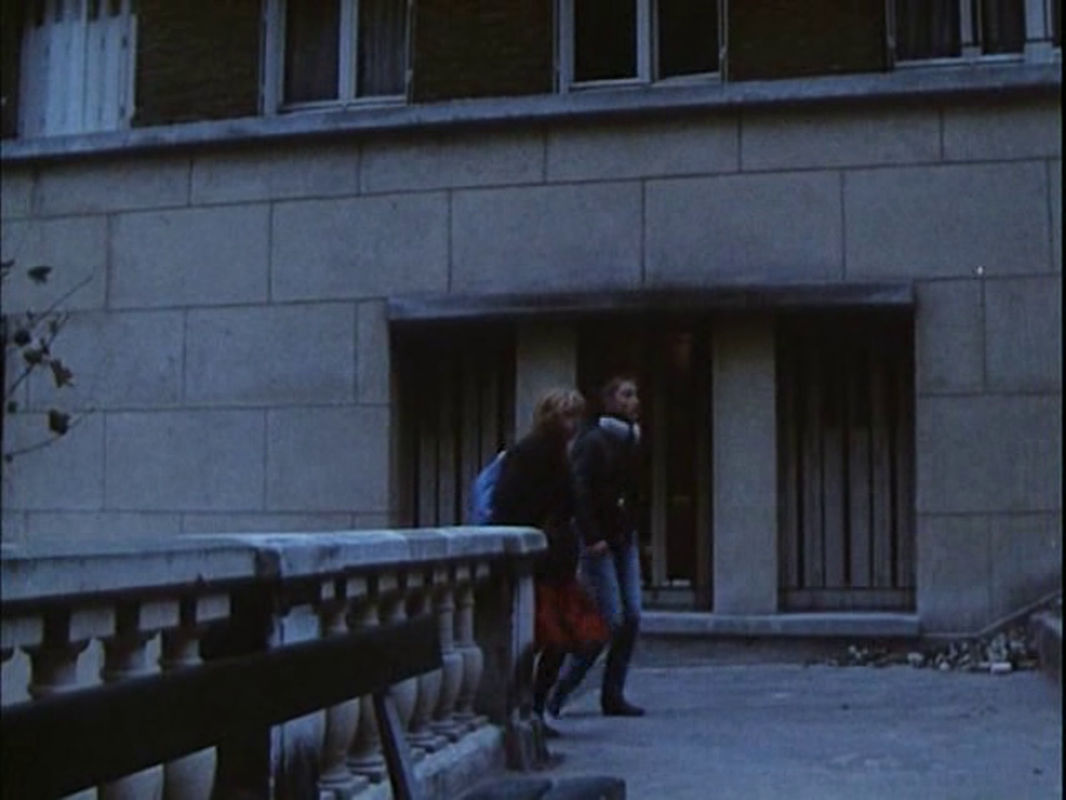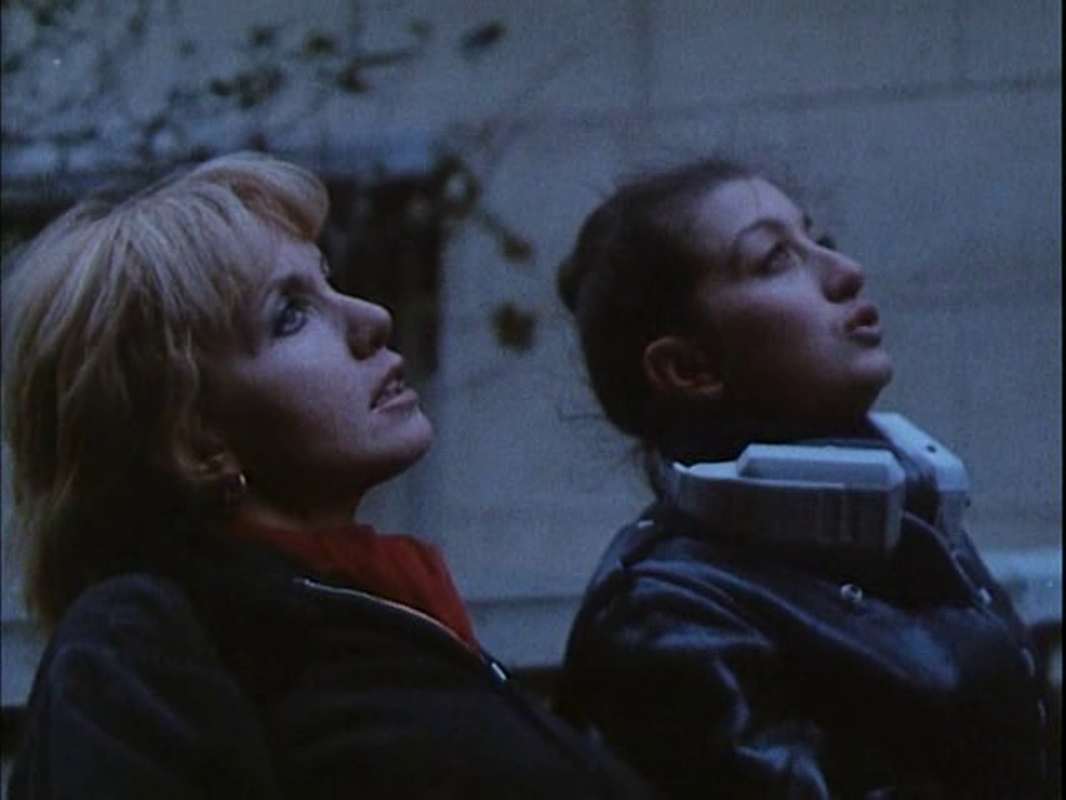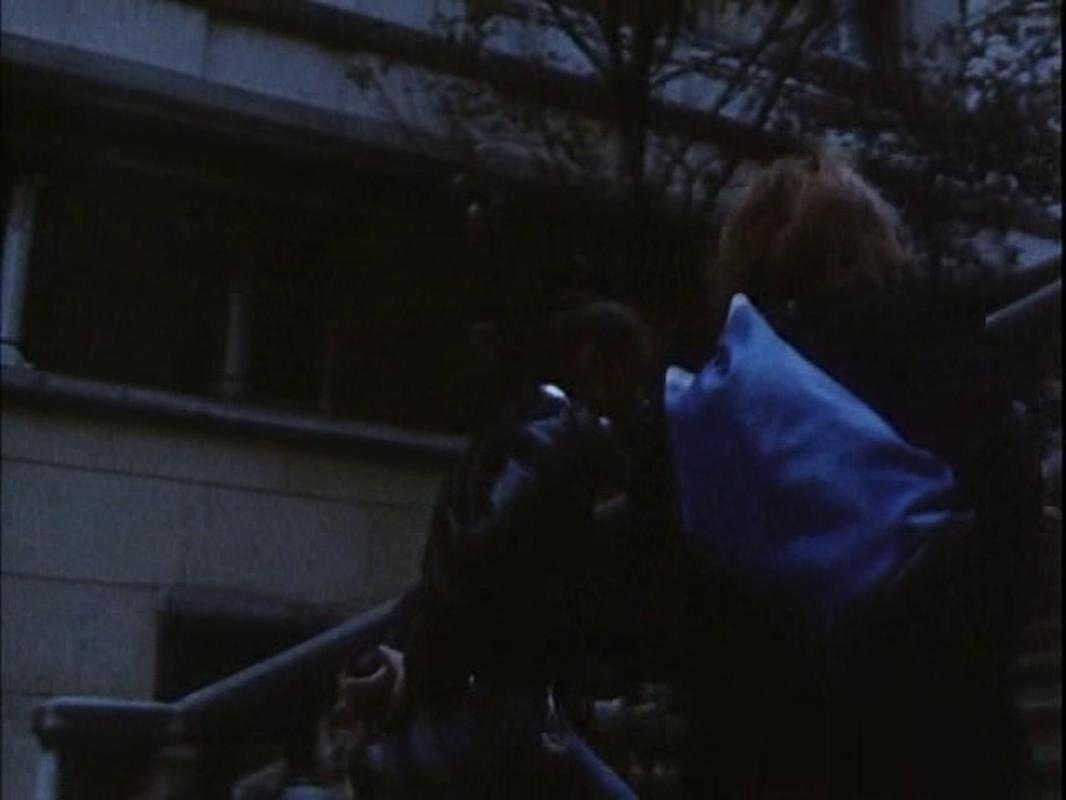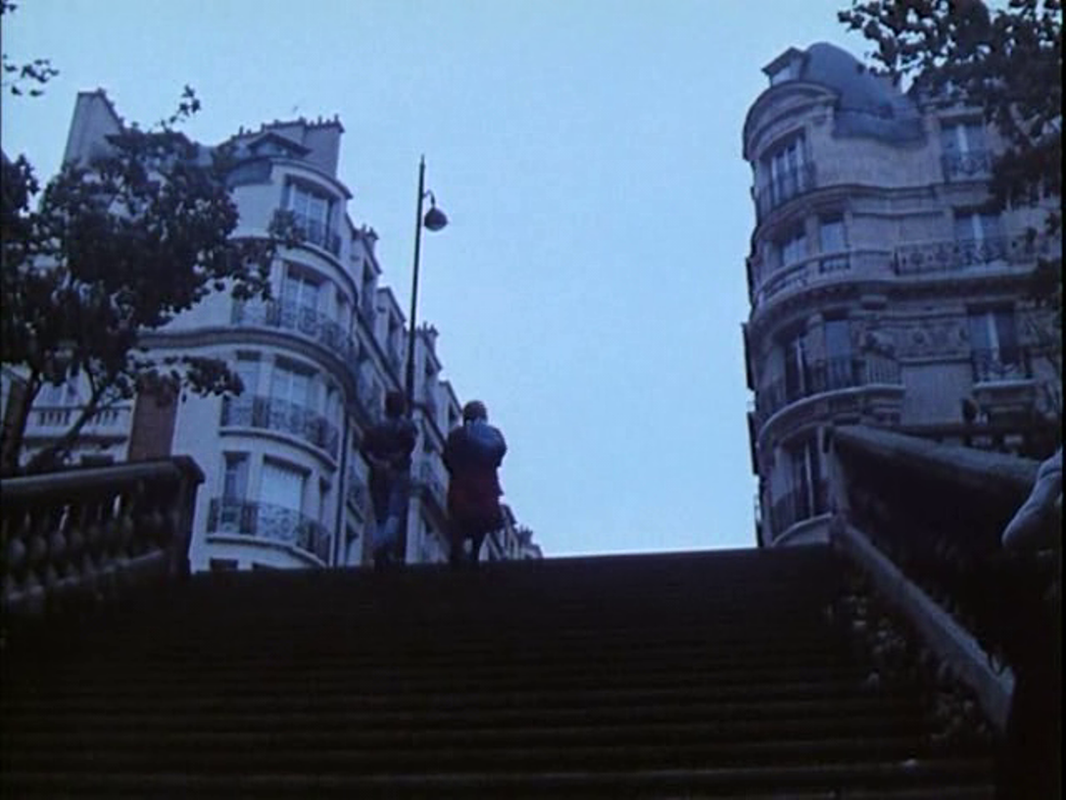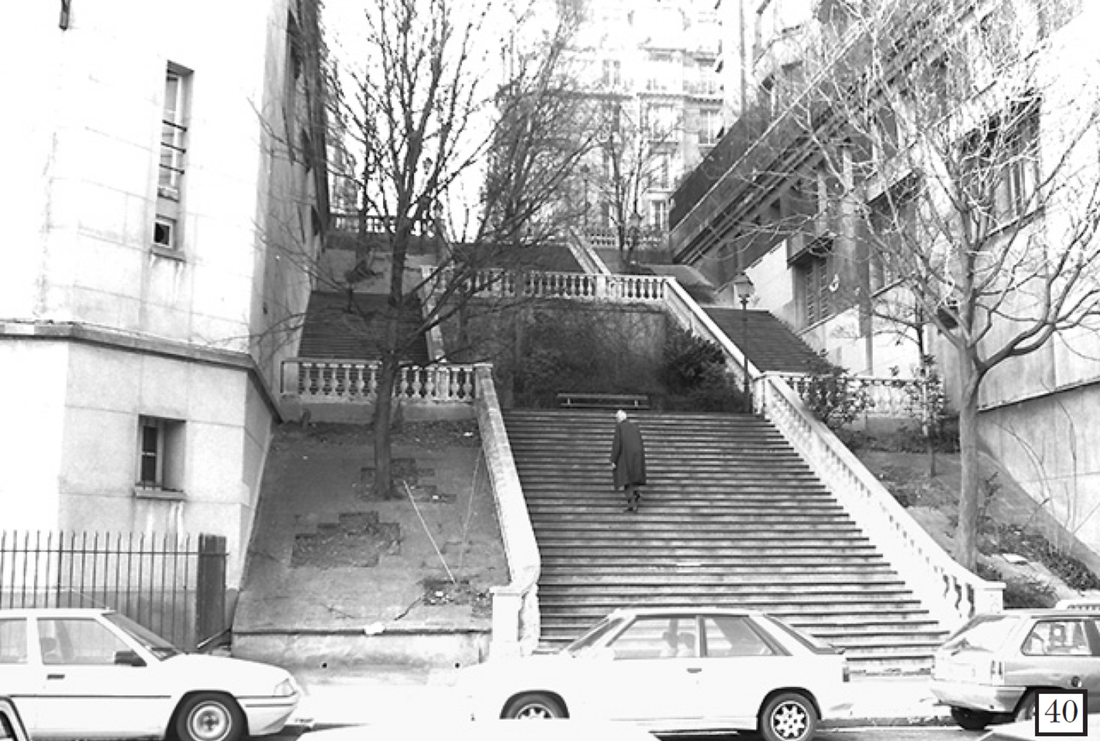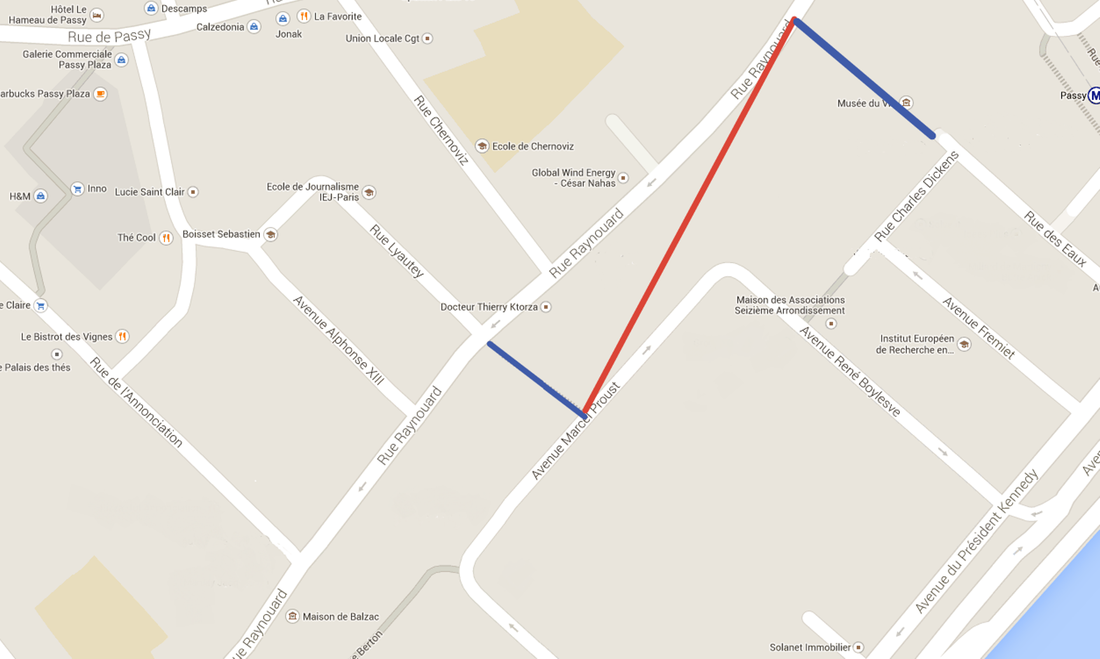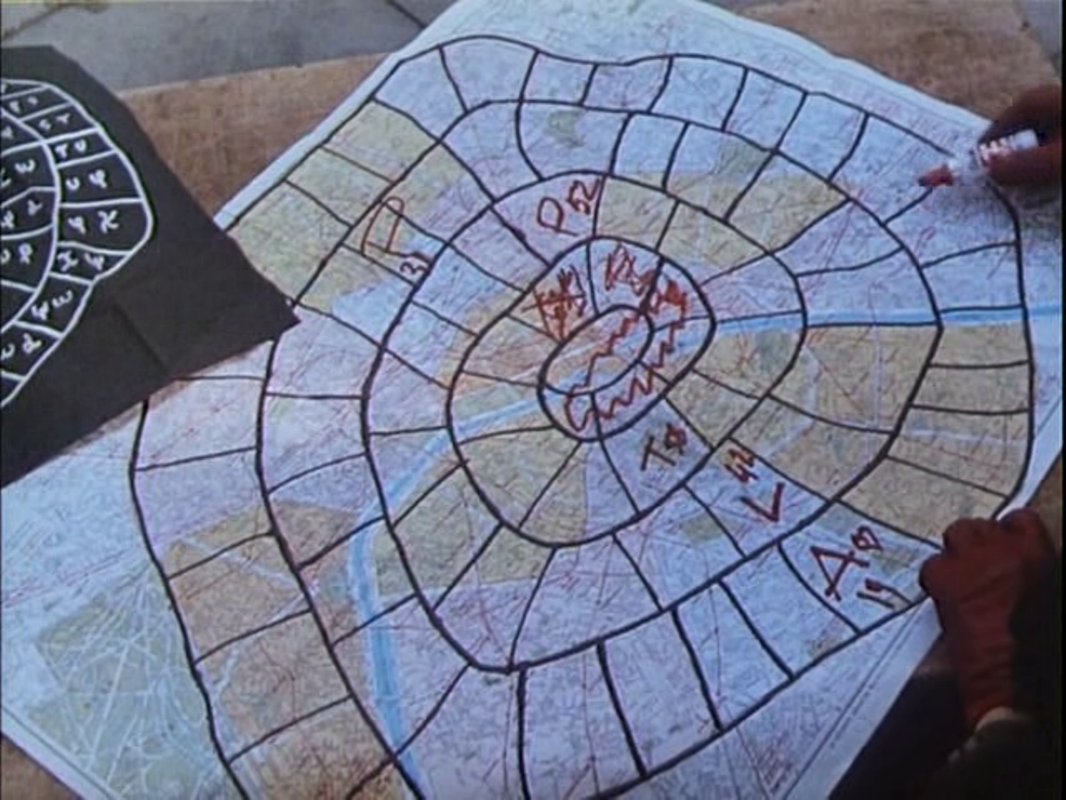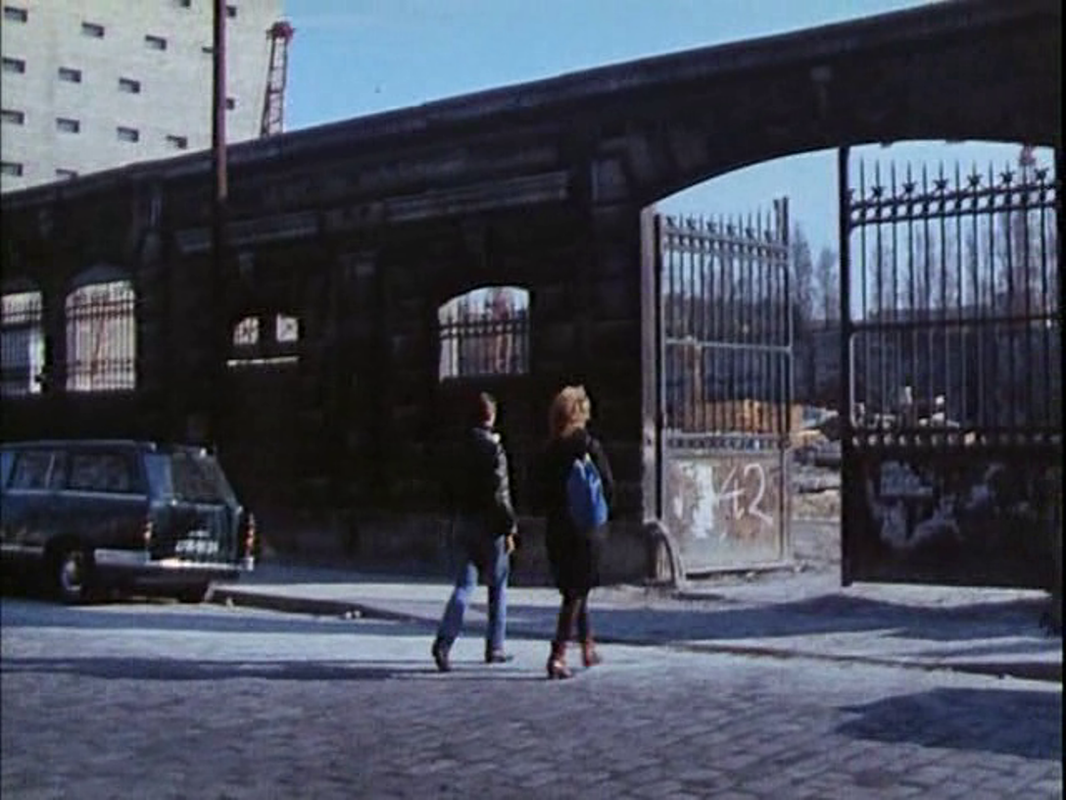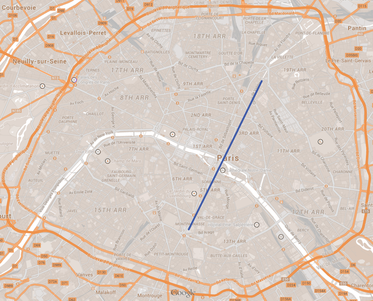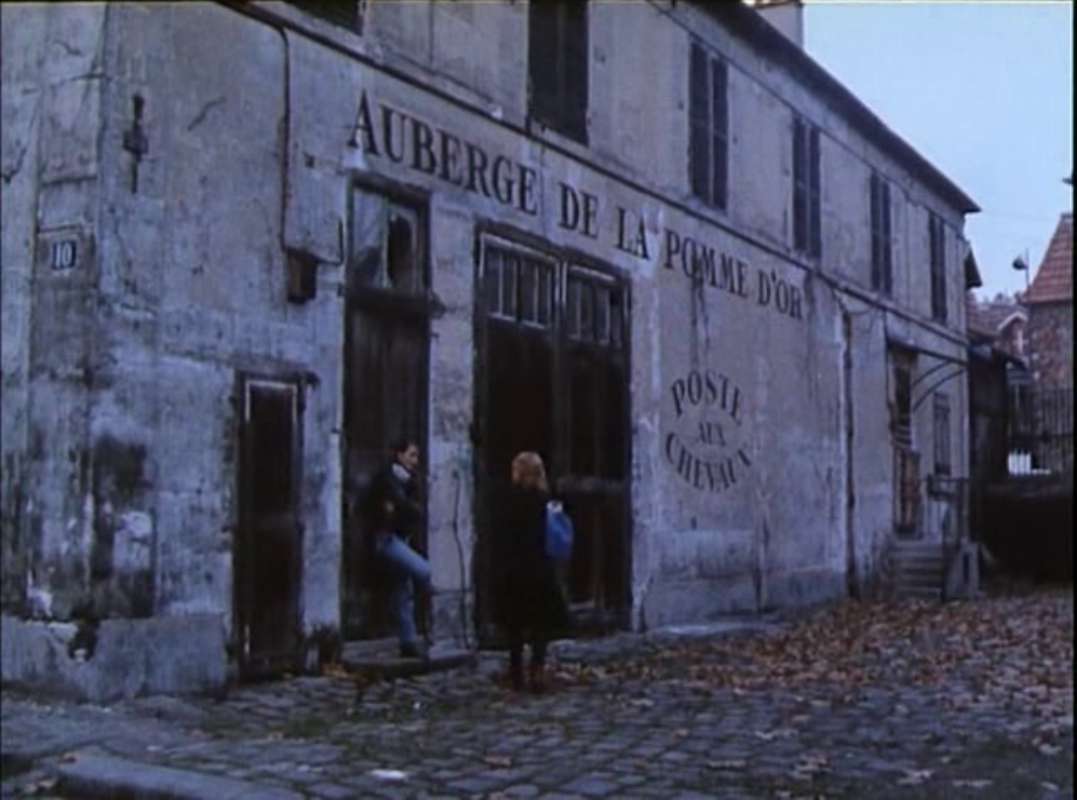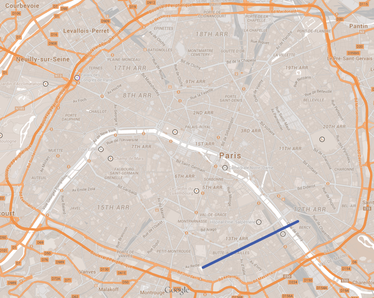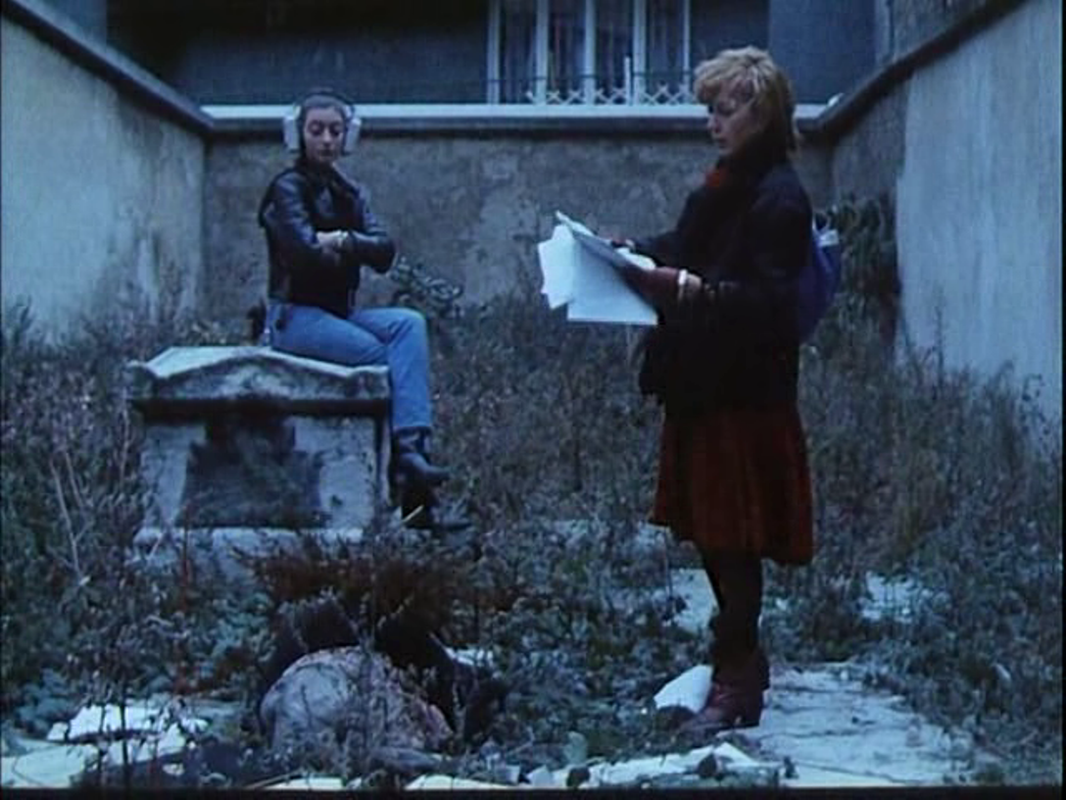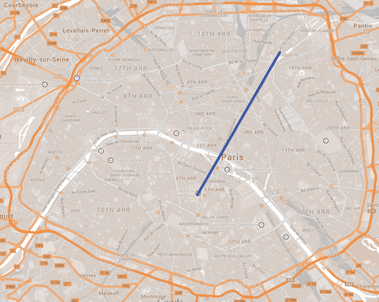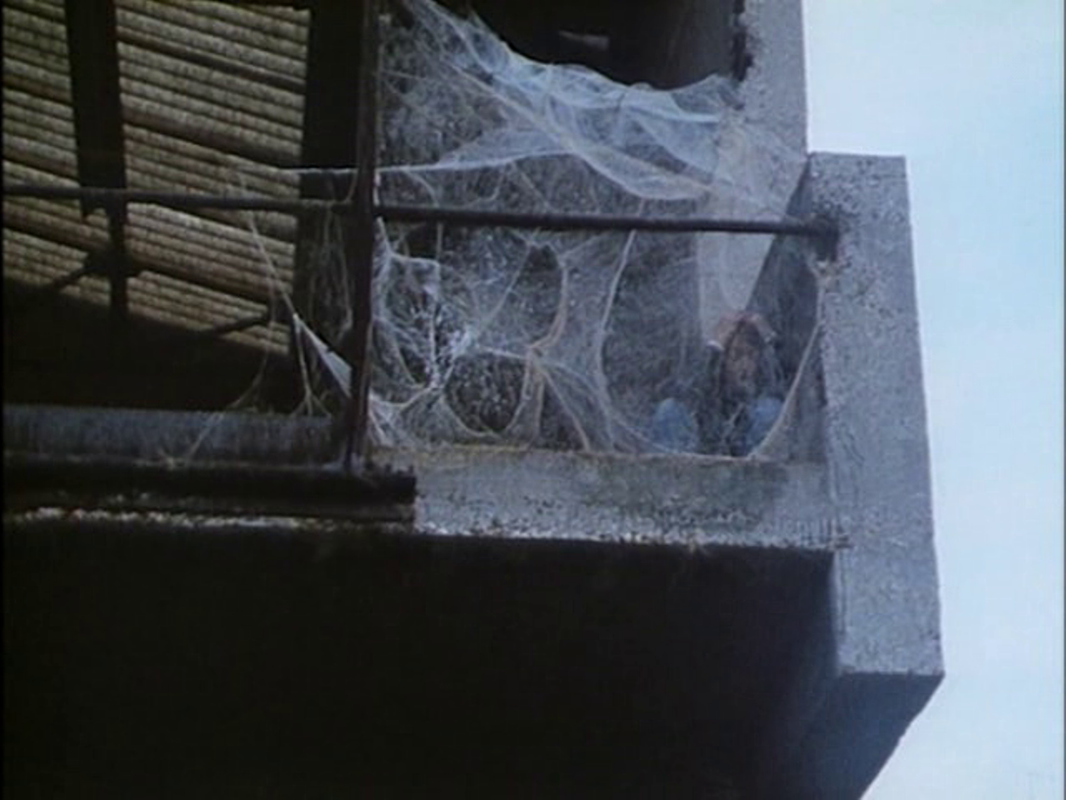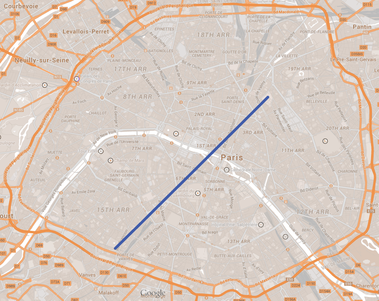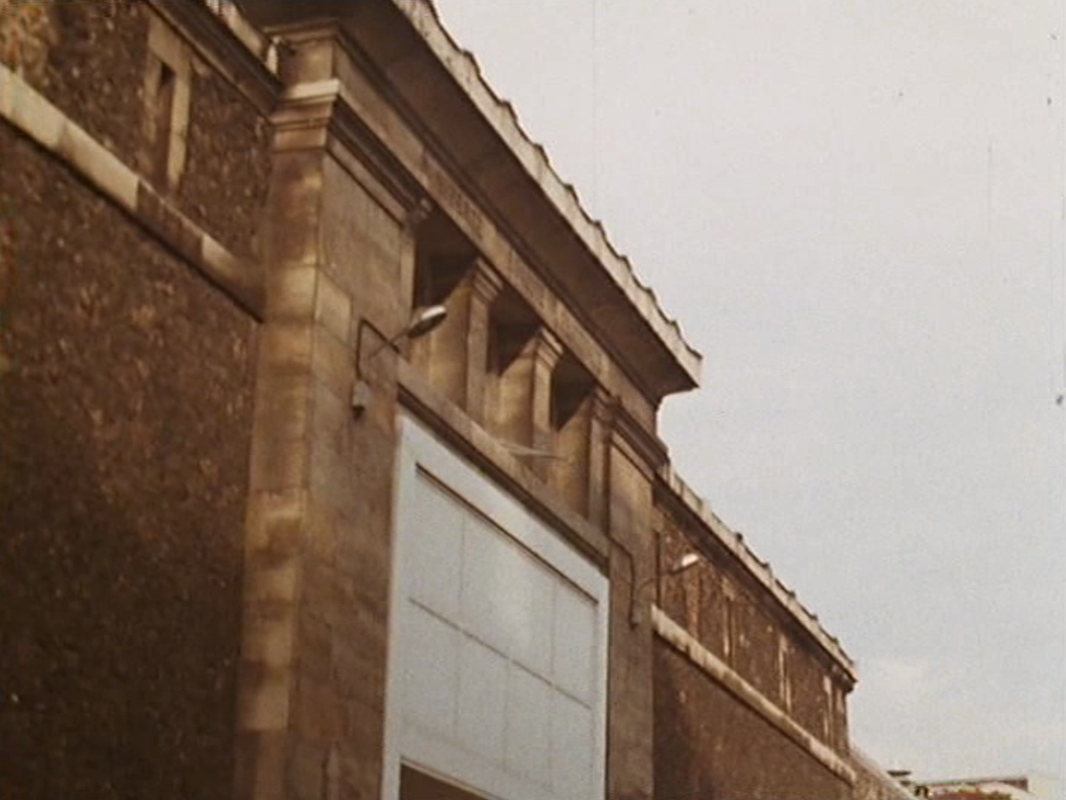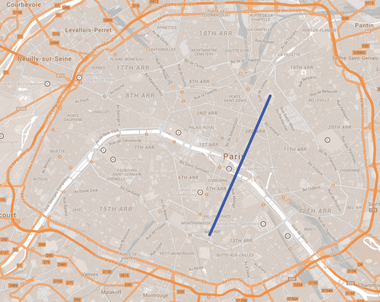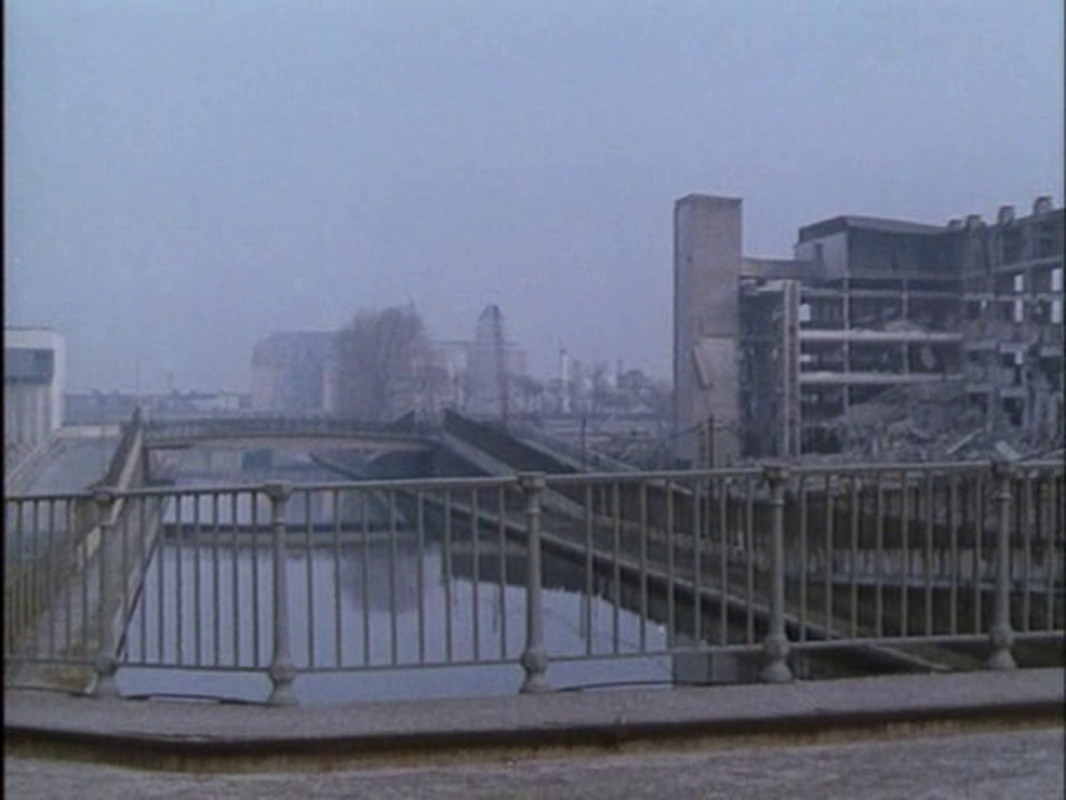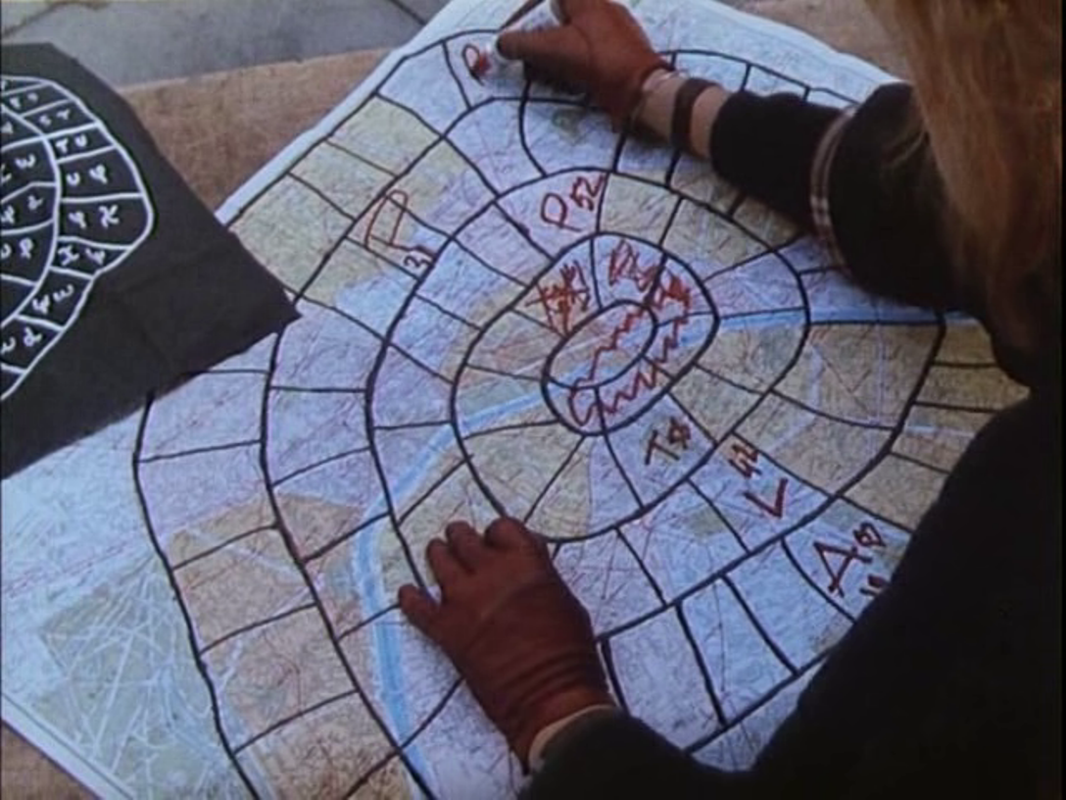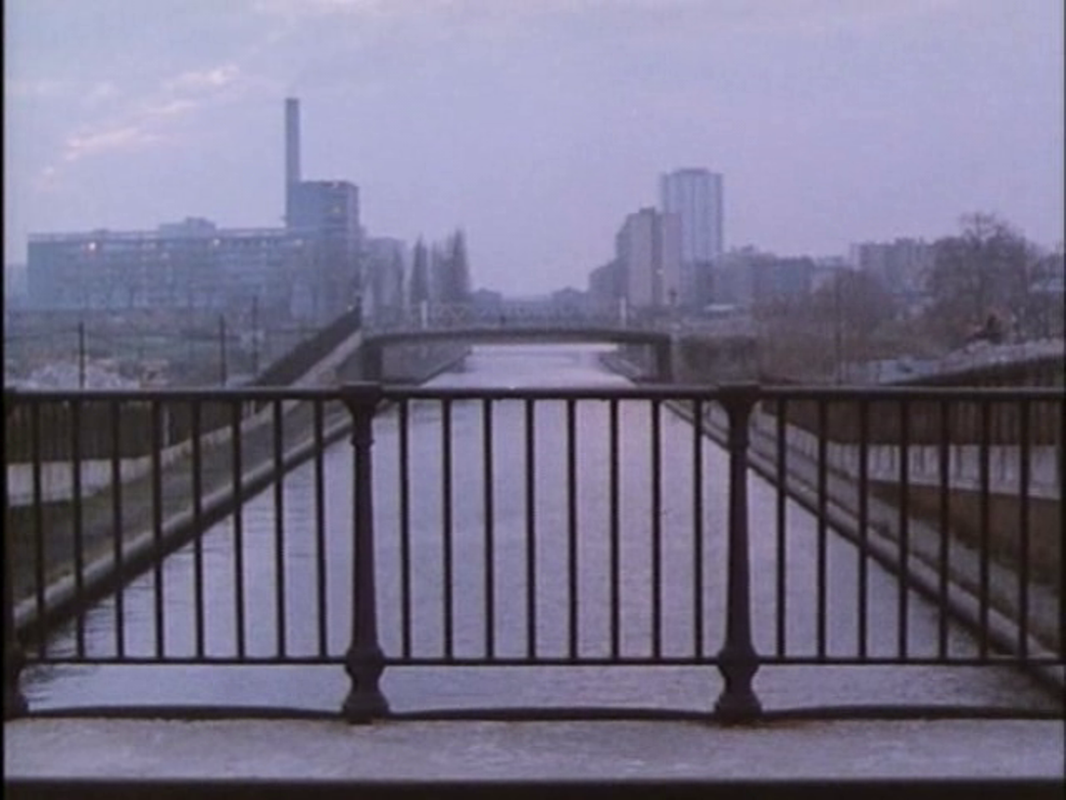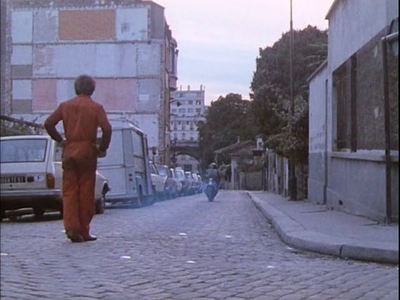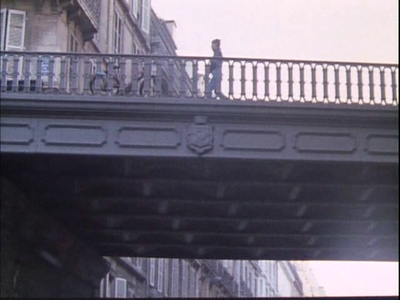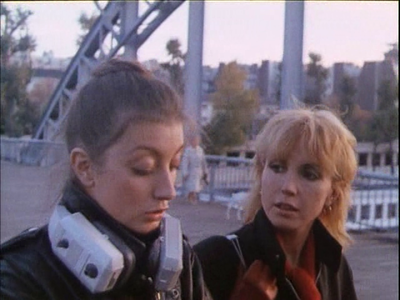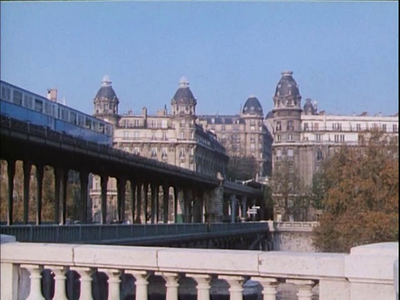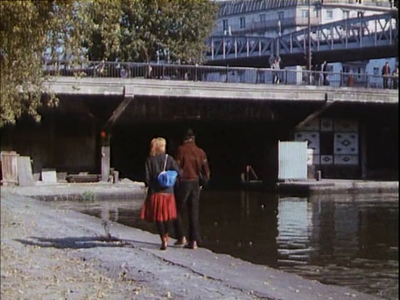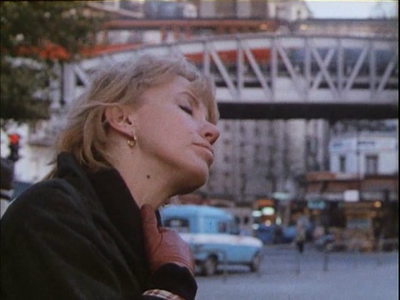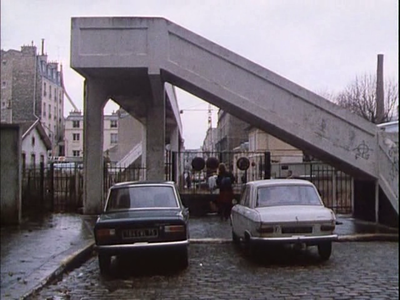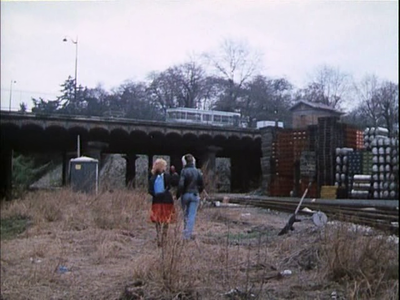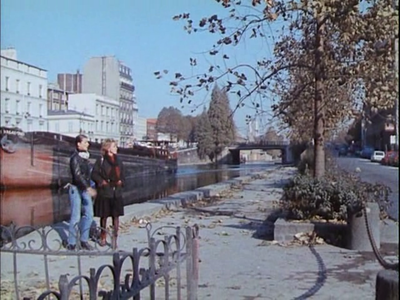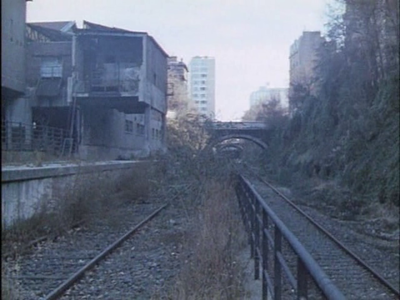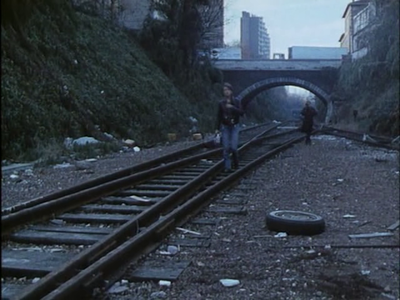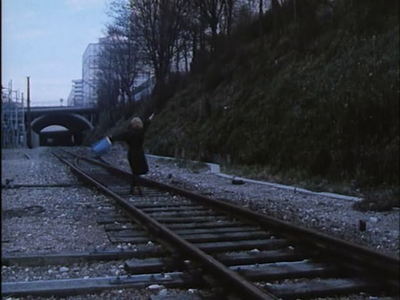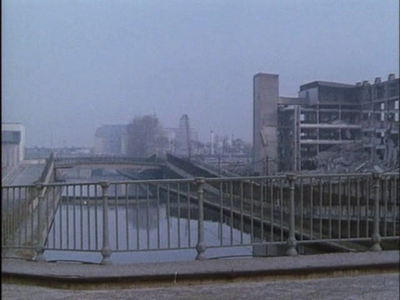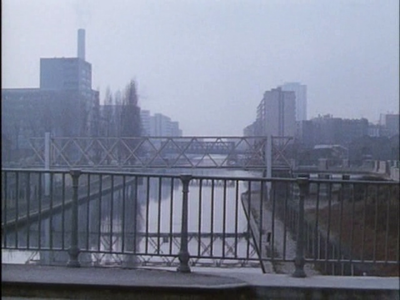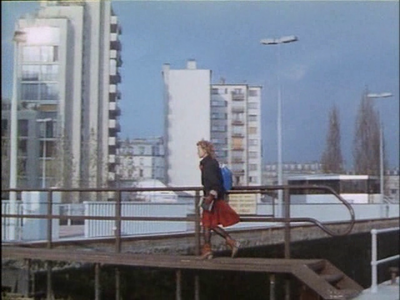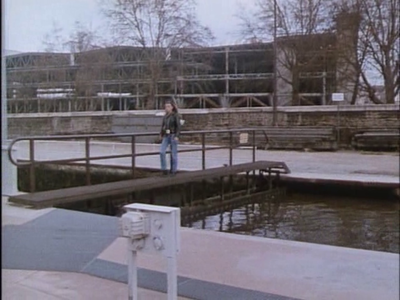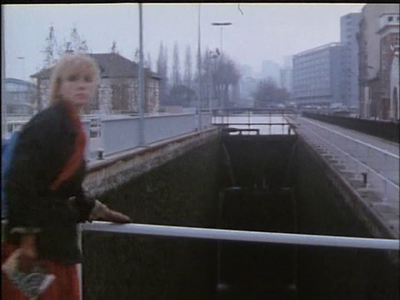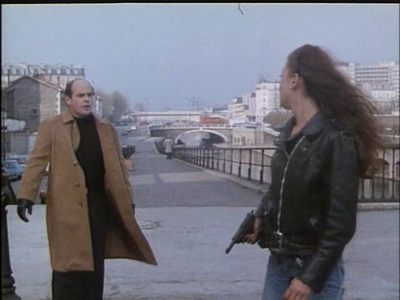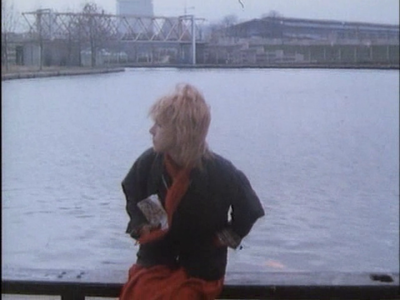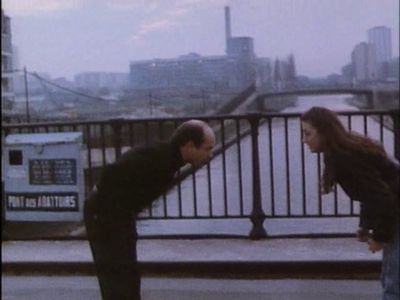topographical telescoping in
Le Pont du Nord
Le Pont du Nord
- Your characters' itineraries sometimes raise a smile,
for example the topographical telescoping in Le Pont du Nord.
- Yes, for someone who knows Paris there are some wholly aberrant spatial leaps.
(interview with Jacques Rivette in Cinématographe 76 (1982), p.36)
for example the topographical telescoping in Le Pont du Nord.
- Yes, for someone who knows Paris there are some wholly aberrant spatial leaps.
(interview with Jacques Rivette in Cinématographe 76 (1982), p.36)
This post, returning to the places of Rivette's Le Pont du Nord (see here), was prompted by my finally finding one of its long-elusive locations after a hint from Caroline Champetier, cinematographer on the film (to whom many thanks).
I had actually been looking for one location but it turns out to have been two. At the joint between the third day of the film's action and the fourth, Marie (Bulle Ogier) and Baptiste (Pascale Ogier) are in a street at night, looking for a car to sleep in. They try several doors and eventually find one:
I had actually been looking for one location but it turns out to have been two. At the joint between the third day of the film's action and the fourth, Marie (Bulle Ogier) and Baptiste (Pascale Ogier) are in a street at night, looking for a car to sleep in. They try several doors and eventually find one:
They are here on the rue de Dantzig, near the junction with the rue Dombasle, 15e:
The next day shows Marie waking in the same car, but on a different street:
The car is now on the rue du Lieuvin, at the junction with the rue Fizeau.
The action of Le Pont du Nord moves through about thirty-two locations in the course of the film's two hours, with more places appearing as inserts unrelated to the action. There is nothing spatially aberrant in these inserts, mostly of statues, which serve as commentary rather than as stages in an itinerary. Nor are most of the narrative transitions between places aberrant; this post is a discussion of those that are.
Le Pont du Nord opens with Baptiste arriving in Paris at the place de la Porte de Montreuil. She is then seen on the rue de la Croix Saint Simon, the place de la Nation, the place de la République and the rue de Lobau before arriving at the place Denfert Rochereau:
Le Pont du Nord opens with Baptiste arriving in Paris at the place de la Porte de Montreuil. She is then seen on the rue de la Croix Saint Simon, the place de la Nation, the place de la République and the rue de Lobau before arriving at the place Denfert Rochereau:
This is a coherent itinerary of which the latter stages are determined by the presence of lions:
Baptiste's itinerary is interrupted three times by views of Marie at the place Denfert Rochereau. This is conventional cross-cutting between protagonists in different places, and it stops once the two women are in the same place.
From then on the film moves in orderly manner from place to place, in the company of both protagonists. The itinerary of Baptiste and Marie through Paris appears to be more chaotic then Baptiste's when she was alone:
This disorder might seem to derive from the reconfigured map of Paris, on which the succession of places is ludic rather than topographic:
But the film's topography is disordered also by those telescopic spatial leaps referred to by Rivette. There are, including the one performed by the car overnight, seven such leaps in the film, of various types.
|
The first occurs after thirteen minutes or so. Marie buys four postcards at a newsstand in the place Denfert Rochereau, 14e. In the next shot, postcards still in her hand (suggesting temporal continuity), she goes into a small square and writes on one of the postcards. This is a square at the junction of the rue Dampierre and the rue Rouvet, eight kilometres away in the 19e. In the next sequence she attempts to post her card at the junction of the rue Sarrette and the avenue du Général Leclerc, back in the 14e, just south of the place Denfert Rochereau.
|
There is nothing particularly distinctive about the square where she writes the card, such that someone who knew Paris would recognise it and smile at the aberrant leap the film had just made.
This is a topographical inconsistency that, I would guess, was designed to pass unnoticed and unread. Nonetheless, there is much in this episode that invites a topographical reading, for example:
- Marie selects her postcards from a carrousel displaying many familiar views of tourist Paris; she chooses a view of the Arc de Triomphe, buying four copies of the same postcard; twelve minutes later she and Baptiste are in front of the actual Arc de Triomphe, where Marie is to meet her lover Julien; fifty minutes later the film offers a panoramic view from the top of the Arc de Triomphe.
- the square Dampierre where she writes her postcard is just two hundred metres from the quai de l'Oise, the place where, at the end of the film, Marie will be killed by Julien. No one would make the connection as they watched the film, but now we cannot help but read the square Dampierre as a topographical prefiguring of Marie's death.
- Marie addresses her postcard to a friend at '42 rue de la Santé', the Prison de la Santé, which is in the 14e, about 600 metres from where she bought the postcard, and 500 metres nearer than the place on the avenue du Général Leclerc where she tries, and fails, to post it - it would have been easier to deliver it directly to the prison. She eventually posts it six kilometres away, in a letterbox on the rue Pierre Semard, 9e.
This is a topographical inconsistency that, I would guess, was designed to pass unnoticed and unread. Nonetheless, there is much in this episode that invites a topographical reading, for example:
- Marie selects her postcards from a carrousel displaying many familiar views of tourist Paris; she chooses a view of the Arc de Triomphe, buying four copies of the same postcard; twelve minutes later she and Baptiste are in front of the actual Arc de Triomphe, where Marie is to meet her lover Julien; fifty minutes later the film offers a panoramic view from the top of the Arc de Triomphe.
- the square Dampierre where she writes her postcard is just two hundred metres from the quai de l'Oise, the place where, at the end of the film, Marie will be killed by Julien. No one would make the connection as they watched the film, but now we cannot help but read the square Dampierre as a topographical prefiguring of Marie's death.
- Marie addresses her postcard to a friend at '42 rue de la Santé', the Prison de la Santé, which is in the 14e, about 600 metres from where she bought the postcard, and 500 metres nearer than the place on the avenue du Général Leclerc where she tries, and fails, to post it - it would have been easier to deliver it directly to the prison. She eventually posts it six kilometres away, in a letterbox on the rue Pierre Semard, 9e.
The second spatial leap looks like a gag about match-cutting. At the end of one sequence Baptiste is walking up a flight of stairs. The first shot of the following sequence shows something very similar:
We may quickly realise that these are two different flights of stairs, matched merely because the film enjoys escalographic forms. If we concluded that in the second shot it is Baptiste on a different day, with a different jacket and her hair down, we realise our mistake as soon as Baptiste herself appears, crossing from right to left in front of the woman in the maroon jacket. At this point Baptiste's movement matches in memory the very end of the earlier shot, in which she had reached the top of the stairs and turned left:
The continuity solution here would be that Baptiste had gone up one set of stairs, turned left and carried on walking past the top of a second set of stairs, parallel to the first, up which, coincidentally, another young woman was walking. Escalographically speaking, it isn't unfeasible to find two flights of stairs in parallel; we shall see an example shortly, and in fact the second staircase seen above is one of a pair, as we see when Baptiste comes down the left hand flight at the end of that shot:
|
The matchings of shape and movement across these two sequences are - you'll excuse the pun - flights of fancy rather than an aberrant spatial leap, but if we did think that there was temporal continuity from one sequence to the other, the ellipsis of space would cover almost six kilometres, between the staircase connecting the avenue René Coty to the rue Saint Yves, 14e, and the staircase connecting the rue Pierre Semard to the rue de Bellefond, 9e.
|
The next three spatial leaps to consider are all of the same type, and come in rapid succession.
The first takes us, across a cut, from the place Gustave Toudouze, 9e, to the passerelle Debilly that crosses the Seine from the 7e to the 16e: a distance of 3.5 kilometres. On one side of the cut Marie asks Baptiste what her name is, on the other Baptiste answers. The soundtrack establishes temporal continuity. This happens again as their conversation continues. Across the cut from the passerelle Debilly to the rue Duméril, 13e (5.2 km), Baptiste says 'C'est le destin', with the cut just before the last word. From the rue Duméril to the following location six kilometres away, temporal continuity again overrides spatial discontinuity, reinforcing sound with gesture. As they walk up the rue Duméril Baptiste has been describing a hidden star, 'une étoile', behind the clouds, but Marie replies that, no, the star is there, right in front of them. She points straight ahead and across the ensuing cut they are at the place de l'Etoile, with the Arc de Triomphe in its centre.
These three contiguous spatial leaps are better represented on the one map:
A less stellar anomaly follows when two different sets of stairs are contrasted. The first is the rue des Eaux, 16e, up which Marie and Baptiste walk in five downwardly angled shots:
These five shots are very similar but there is a pattern of right-to-left/left-to-right orientation in the camera's angle, meaning that when the women reach the camera's position they walk past it and out of frame alternately to the left and to the right:
This pattern in the staging and framing imposes an order on the irregular forms of the stairway, a sense of control that continues when the last of the five shots rises slightly and is followed by two upwardly angled views of a stately lion, again with a right-to-left shift in orientation:
The inserted lion, one of a set on the pont Alexandre III, 8e, is not linked topographically to the rue des Eaux, and serves to remind us that the spatial organisation of this screen city is as much about montage as it is about mise-en-scène or camerawork.
The second set of stairs in this contrastive episode is the avenue du Parc de Passy, which does have a topographical link to the rue des Eaux, being two hundred metres from and more or less parallel with it:
The second set of stairs in this contrastive episode is the avenue du Parc de Passy, which does have a topographical link to the rue des Eaux, being two hundred metres from and more or less parallel with it:
As with the previous set of stairs, movement from bottom to top is rendered in five shots, but unlike the first case there is great variety in the framing and angle. The first shot begins looking down the stairs towards Marie and Baptiste but it pans to follow them as they pass and finishes by looking up the stairs.
The second shot begins from a horizontal position and as it follows the women ends by angling up the stairs again:
The third shot remains horizontal but adjusts as the women move towards a bench on a landing. The fourth shot is a close up of them, seated:
The fifth shot, like the second, begins horizontally and finishes angled upwards as they reach the top of the stairs:
Unlike the five matching shots that show their progress up the rue des Eaux, there is no regular or formal pattern to the staging and framing of this ascent. This difference matches by contrast a difference between the two sets of stairs: contrasted with the six flights of arbitrarily varied length that make up the rue des Eaux, the avenue du Parc de Passy is an impressively symmetric composition:
This last discussion might have been better placed under the sign of l'Escalographe, since how these two sets of stairs are rendered by Rivette's film has no bearing on the aberrant spatial leap that occurs at this juncture.
The women walk up the rue des Eaux and reach the rue Raynouard, but then they are on the Avenue Marcel Proust, from where they walk up the avenue du Parc de Passy and reach the rue Raynouard again. The leap here - marked in red on the map below - is only 200 metres, but is just as unfeasible as any of the others so far.
The women walk up the rue des Eaux and reach the rue Raynouard, but then they are on the Avenue Marcel Proust, from where they walk up the avenue du Parc de Passy and reach the rue Raynouard again. The leap here - marked in red on the map below - is only 200 metres, but is just as unfeasible as any of the others so far.
On the rue Raynouard, 140 years before, lived Balzac, whose L'Envers de l'histoire contemporaine is a pretext for Le Pont du Nord. One more 200-metre leap and the women would have been at his house. For a long time I thought that the square in which they spend the night immediately after this sequence might be the garden of Balzac's house, but actually it is two kilometres away, in the 15e.
The Passy stairs sequence marks the end of the film's first day, and - with the one exception of the moving car - the end of the film's aberrant spatial leaps. On the morning of the second day they acquire the reconfigured map of Paris. Though they don't actually identify places on it until the morning of the third day, it is on the map that the topography of the city will now be telescoped, or more exactly in the leaps made between the places indicated on the map and the places they correspond to in the film.
The Passy stairs sequence marks the end of the film's first day, and - with the one exception of the moving car - the end of the film's aberrant spatial leaps. On the morning of the second day they acquire the reconfigured map of Paris. Though they don't actually identify places on it until the morning of the third day, it is on the map that the topography of the city will now be telescoped, or more exactly in the leaps made between the places indicated on the map and the places they correspond to in the film.
The first place they go to is the Labyrinth. This space, marked with an L and the number 42 on their map, covers the north-east corner of the 14e arrondissement, but the place they go to in the film is in the 10e, by the Canal Saint Martin:
The next space they go to is the Auberge, the Inn, marked A and 19 on their map. It covers the south-east corner of the 14e, but the place they go to, the wine dépots at Bercy, is in the 12e:
They had previously been to the Tombeau, the Tomb, which in their map covers the 6e around the Luxembourg, but where they went was the 'cimetière des juifs portugais', on the avenue de Flandre, 19e:
Baptiste interprets the episode where she is caught up in spiders' webs as the Prison, which on their map is marked P and 52 and corresponds to the eastern side of the 10e. Baptiste was emprisoned, however, at the former Petite Ceinture station of Vaugirard, in the 15e:
There is an actual prison in the film, the one to which Marie sends a postcard at the beginning. It doesn't appear in Le Pont du Nord but we do see it in the film's companion piece, Paris s'en va. If the real place corresponding to the Prison space in the game is meant to be the Prison de la Santé, then the spatial leap between map and the pro-filmic reality looks like this:
When they last consult the map Marie and Baptiste have to choose between going to Le Puits, the Well, the space marked 31, or to Le Pont, the Bridge, marked 6. They choose Le Pont, since we next see them coming up some stairs that lead to a bridge, the first of the bridges crossing the Canal de l'Ourcq after the junction with the Canal Saint Denis:
|
This is in the 19e, and the place Marie marks as Le Pont on their map is exactly this part of the 19e. For once the place on the map corresponds to the place on the film. Aptly, we are here at the climax of the film, and we are, here, on a bridge in the north of Paris, a pont du nord. The film actually ends on the next bridge along, with Baptiste and Max fighting a dance or dancing a fight. This too is a pont du nord:
|
There are many other bridges or associated modes of crossing in Le Pont de Nord. I think this is all of them:
